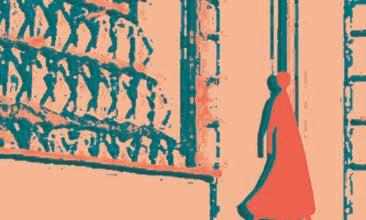

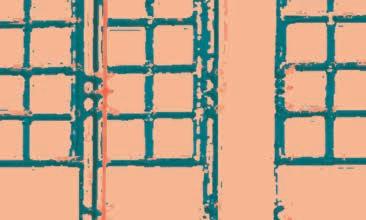

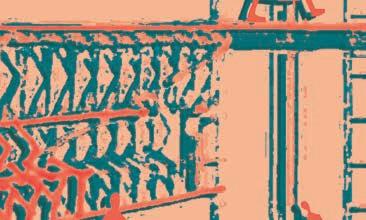
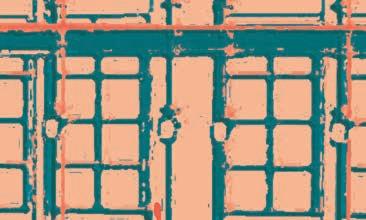









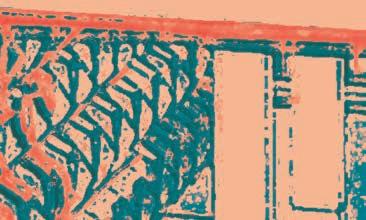








2023 MORE
MMORE 2023
ISBN: 978-1-8383870-3-7
Cover image Nishika Diyabalanage
Designed & produced Clare Hamman
First published September 2023
Printed London
© University of Westminster
Contents Introduction MA Interior Architecture Introduction Theses MA Architecture Introduction Theses MSc Architecture & Environmental Design Introduction Theses MA Urban Design Introduction Theses MA International Planning & Sustainable Development Introduction Theses MA Tourism & Events TBC Introduction Theses MSc Air Transport Planning & Management Introduction MSc Logistics & Supply Chain Management Introduction MSc Transport Planning & Management Introduction Theses MA Urban & Regional Planning Introduction Theses Practice & Study Introduction RIBA Part 3 Live Design Practice Research Introduction Research Groups Selected Research PhD Department of Architecture Staff Sponsors 2 6 7 14 15 20 22 26 28 30 32 34 35 36 37 38 39 40 41 42 44 48 50 52 54 70 76 78
WELCOME TO MORE 2023, and to the celebration of our postgraduate students’ work from the past year. After two smaller shows following the pandemic, this year we have a larger, more comprehensive exhibition that truly reflects the endeavour and achievements of our postgraduate and research community.
The exhibition reflects the unique combination of disciplines in the School, and the practice of students and staff in addressing regenerative and resilient Design, Making, Place, Spatial Policy, Mobilities, Territorial Transitions and Professional Practice. As before, the event is being streamed and the outputs (and catalogues) shared online, giving us a global reach that matches the nature of the School’s students and staff: a rich mix of views and approaches that is critical to our ability to address contemporary challenges and long-term resolutions. Our studentstaff climate action taskforce, ArCCAT, Equity Forum, and Cross-Disciplinary Exchange have given a lead to our work and, alongside the work on show in MORE, our website openresearchwestminster.org showcases the research and knowledge exchange in our five complementary research groups, and our world-leading research centres.
2022-23 has seen a larger than usual number of staff leaving and joining. With a deep sense of gratitude, we said farewell to our long-standing colleagues Stephen Brookhouse, Anne Graham, Chantal Laws, Tony Lloyd-Jones, Maja Piecyk and Allan Woodburn who retired after having given so much to the School and their disciplines; we have also welcomed Conor Clarke, Luz Navarro, Tassew Tolcha and John Somers, who is leading our new MA Urban & Regional Planning Apprenticeship.
We hope you will enjoy the show and get a feel for the creative serendipity that characterises the day-to-day life of the School. MORE is only a reality because of the endeavour of many. To Nasser Golzari and Yara Sharif, who designed and curated the exhibition, and Daniel Scroggins who organised the whole thing. To Clare Hamman who has designed and produced this beautiful catalogue. Our thanks go to our campus team led by Amaniel Gebreyesus, Kow Abadoo, and Chris Meloy for their help mounting the show. François Girardin and the Fabrication Laboratory staff who helped build the exhibition. Mirna Pedalo who curates our website [more2023.net] and social media. And thank you to all our students and the staff.
Please enjoy the show.
Harry Charrington Head of the School of Architecture + Cities
2
Welcome to MORE 2023
4
MASTERS
David Littlefield (Course Leader), Nick Beech, Conor Clarke, Dusan Decermic, Maja Jović, Paresh Parmer, Simon Banfield, Tomasz Dancel-Fiszer, James Engel, Clare Hamman, Ed Harty, Bruce Irwin, Debbie Kuypers, Anna Mansfield
David Littlefield is Senior Lecturer and has written, co-written and edited more than 10 books on architecture and cities. His research focuses on authenticity, heritage, regeneration and notions of place. He is presently undertaking a PhD into the representation of authenticity.
MA Interior Architecture
Students: Niharika Akshara, Yara Al-Hasawi, Yasmeen Aliesa, Ma Aleinna Majan Hilal Almukhaini, Ghadeer Alqallaf, Shivanshi Pranavbhai Amin, Mirna
Aodesh, Mohammad Asif,Tasneem Azeez Matcheswala, Raina Bafna, Rashmie
Balamurugan, Dinemis Balkaroglu, Jagruthi Bangalore Murthy, Ahmed
Khalil Barka, Blerina Berisha, Denzel Chabata, Atcharaa Chandrasekar, Rasika Rajendra Chitodkar, Shenon D Costa, Nishika Diyabalanage, Anna Duldig, Aysen Aysu Ergul, Morvarid Farhoodi, Yiwen Fu, Iveta Hanzenova, In Ut Ho, Sarafina Jozefzoon, Tanvi Arun Kale, Pallav Kapoor, Kayser Khalid,
OUR INTERIOR ARCHITECTURE MA promotes a speculative approach to spatial design that is rooted in theory and the world of ideas. Those ideas, however, are deployed to confront contemporary questions and challenges. This MA course, therefore, is both conceptual and pragmatic; experimental and rigorous. With a special focus on people and place, the course encourages students to develop a deep sympathy for the needs and aspirations of the users of a space, as well as a sensitivity towards (and response to) physical and social contexts.
Our MA programme provides a platform for students to develop personally and professionally, comprising a set of study modules that can be grouped into three categories: theory; technical substantiation; and design. These tacitly support each other, deepening students' understanding of place and site, their appreciation of the notion that design and social practices are forms of cultural production, and a way to develop the fundamental methods and skills to conduct and present research and critical thinking.
Students then progress to develop their own major project, through either a design proposition or a written thesis. We strive for a rich, mature synthesis of learning, a process
Rebal Khan, Gunjan Khemka, Xiaopeng Liang, Gazala Malik, Faezeh Mirzaei, Anushka More, Prashant Lilabhai Odedara, Natalie Olesen, Silvi Pramodbhai Panchal, Pratiti Devanshu Pandit, Serena Patel, Senuri Peththawadu, Maria Laura Polselli, Aishwarya Ramesh Kumar, Dewanti Ratnasarira, Layal Rmeih, Jinglu Ruan, Sahil Sachdeva, Sara Sahebgharani, Laura Sumardi, Zhe Sun, Tala Talj, Kanaka Dhirendra Thakker, Fateme Toofany, Nithya Shree Viswanathan, Xiaochuan Wang, Yi Wang, Weijia Yu, Alveena Zahid, Tianle Zhao
aimed to prepare students (academically, professionally and personally) for the challenges of a complex world.
This year, students were provided with a range of options for their major thesis study; some selected their own site and theme for investigation, while others opted to explore guided themes based at selected sites: housing; cinema (working with the Regent Street Cinema in central London); potential futures for Oxford Street's House of Fraser department store; and the adaptive re-use of the historic Bargehouse building on London’s South Bank.
The results were diverse, ambitious and extraordinary, representing the dynamism and diversity of our students, and reflecting their freedom and encouragement to embark on design-led adventures here at Westminster. Ranging from experiments with replicating space and recording the ‘voice’ of a site, to designing for moving bodies, and seeking inspiration from 19th-century clothing. We seek to inspire a strong connection with, and response to, place; what our students have done is both respond to the demands of a particular site as well as offering new and surprising interpretations of the physical and social contexts in which they find themselves.
Guests and Critics: Ying Man (Regent Street Cinema) , Jo Prosser (Royal Academy) , Bruce Weil (Lighting designer)
6 Masters | MA Interior Architecture
Maria Laura Polselli The Parasite of Oxford Street
ARE ALL DEPARTMENT stores fated to become empty carcasses for a parasite to wear? This thesis explores the relationship between a historic ‘host’ (architecture) and its extrinsic interventions, finding architectural beauty in the notion of parasitic growth in a site-dominant intervention which acts as a catalyst to sustain human memories inside a structure that has decayed with time.
This adaptive reuse strategy challenges the nature of retail itself, presenting architecture as a sculpture to display and interact with, instead of just being a box containing goods to sell. To align architecture with this ‘biological’ reality, it investigates the relationship between the building and the visitor, using olfaction as a parameter through which to measure the design and presence of this parasitic development of the built environment.


The former House of Fraser is the setting for the birth of this ‘parasite’. Growing in crystal-like aggregations, it





expands into the voids of the building, attaching to stairlift cores and vertical elements. It overwhelms the original structure and creates a new organic being, a strange and compelling hybrid.

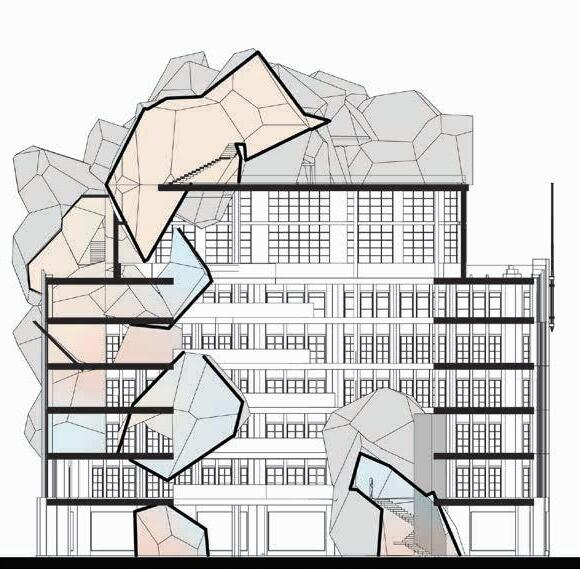
The first bone-like structure, based on a 3D voronoi pattern, are appended by a second layer of soft and light textiles with which the public interact. Through a hidden ventilation system, each voronoi module is pervaded with scents, creating an ethereal atmosphere. This secondary system prompts the visitor to smell, touch and hear, measuring the surroundings with their body.
Growing volumes within an existing shell, this new life form conquers Oxford Street and proliferates on an urban scale, provoking wonder, terror and incredulity. Ultimately turning into an inhabitable superstructure, these scented pathways create a new viability system, reanimating the city and beyond.
MA Interior Architecture | Masters
Weijia Yu A Daydream: Breaking the fourth wall
THE CONCEPT OF the project is to re-imagine the experience of the cinema, translating the interface between dream and reality from film into an architectural space. Working with Regent Street Cinema, the thesis aims to break down the fourth wall between the stage screen and the auditorium, converting this central London venue into an experiential cinema which offers different ways to watch and engage in films.
The project started by analysing the Japanese Noh theatre, extracting the concept of the mirror room and transforming it into a physical reality. The element of mirrors connects the spaces so that they are both independent of each other but integrated, breaking the fourth wall in a new conceptual way. Translated to the Regent Street cinema, with its historic stage and cinema screen, the thesis creates areas with different atmospheres where cinema can become a
performance and live theatre can be distanced by the screen. Through analysis of two films: Alice in Wonderland and Inception, emotional experiences and triggers from these two films were identified and re-imagined within the physical reality of the cinema, creating interconnections and interactions between the spaces and how films would be experienced and viewed.
The design transforms the entire cinema space by creating areas with emotional and experiential differences which visitors can move through to heighten or counteract the experience of watching the film; breaking the fourth wall of the screen and mirroring various views. For example, the intimate and enclosed safe area of the small viewing room, the dining area where you can taste and imbibe with Alice, or the relaxed lounging auditorium.

8 Masters | MA Interior Architecture
Kanaka Thakker The Extended Body
THIS DISSERTATION CONSIDERS the relationship between the body and its surrounding space, conducted through extensive study of various fields like ergonomics, anthropology, psychology, sociology and philosophy. The thesis began as an investigation of compact formats of living for non-family units and to understand how the body navigates tight spaces. The analysis of the body, its movements and gestures while performing daily rituals led the focus of the dissertation to the question, ‘how does the body inhabit space?’

Using an auto-ethnographic research methodology to study the act of performing various everyday activities like watching TV, dressing and cooking, it was observed that the body engages with various objects and surfaces, using them as its extensions.

For example, in an activity as simple as sleeping, the body at times starts using objects like pillows, mobile and blanket as extensions of the body and sometimes it sinks into the horizontal and vertical surface of the bed for support. One could almost look at this exchange between the body, objects and surfaces as one entity, that is the ‘Extended Body’. Stating that the ‘Extended Body’ is more complex than allowed for by simple ergonomics and metrics, the dissertation recommends further investigation into this concept to help design more ergonomically-aware habitable spaces. It also proposes applying the concept of the extended body across various scales of built form to design inclusive cities.
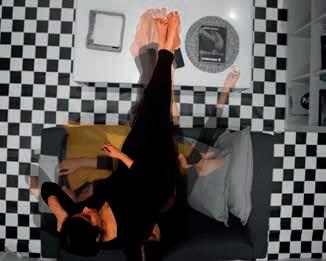
MA Interior Architecture | Masters
MA Interior Architecture theses 2023 contd. Aysen Aysu Ergul
Mohammad Asif
The Home for Graffiti
This thesis transforms the abandoned Bishopsgate Station into a gallery to graffiti and street art. The exhibition space mirrors the nearby graffiti archways, capturing the mutable art form for broader public engagement while preserving the artists' anonymity.
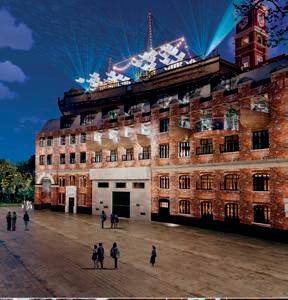
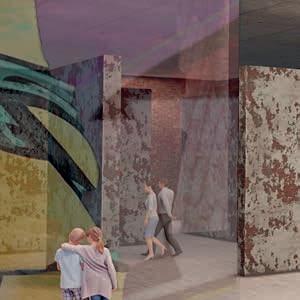
Rashmie
Balamurugan
Beyond the Silver Screen: Unveiling cinematic wonders
Staged behind the screen of Regent Street Cinema, the UK's oldest cinema and one of only three of London's original West End cinemas, this thesis sets to capture the romance and nostalgia of cinema's golden age. Inspired by cabinets of curiosities, it proposes an interactive archive to celebrate cinema's heritage.
Nishika Diyabalanage The New Women of Oxford Street
This research-based project sets out to challenge the patriarchal domination of our urban environment. The thesis incorporates kinetic partitions within each floor of the former House of Fraser store on London's Oxford Street, empowering women and giving them agency to control spaces within the singular structure. It also promotes community and social interactions by seamlessly transitioning from private to public areas.
Emergency Temporary Housing: Examinination of sustainable construction
Growing from the major Turkish earthquake of 2023, this thesis looking at the development and consequences of how emergency architecture is a developed and implemented. It explores issues including alternative building materials, longevity of use and the architect's responsibility.
Natalie Gabriella Olesen
Primary Learning in Urban and Natural Environments
This thesis proposes a progressive exemplar for the future of learning environments, transportation, communication and collaboration. This vision radically transforms the disused House of Fraser store on Oxford Street and imagines a series of healthier alternatives to the building’s make-up, allowing for a stimulating learning environment where children can develop their highest potential.
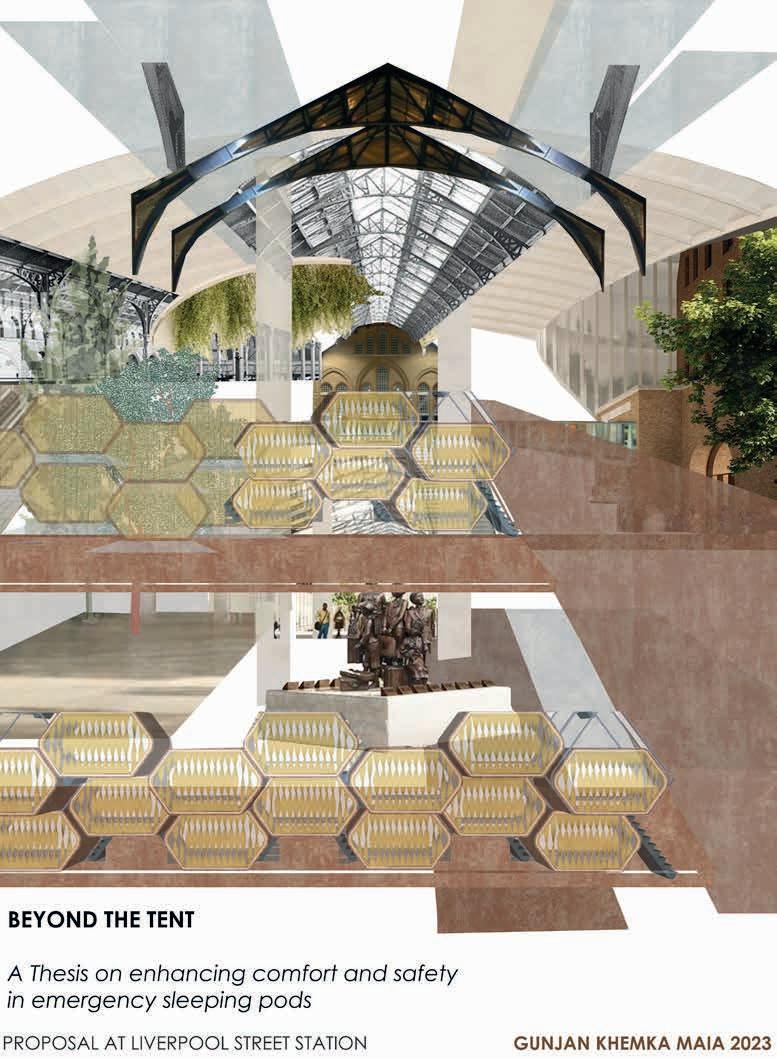
Pratiti
Devanshu Pandit
Co-Living: Co-working
This thesis re-imagines the Bargehouse as a co-living and work space, reviving the materials and atmosphere of the original building. This is approached in a sustainable and economic way, ensuring the spaces can be offered to users at a low cost.
Raina Bafna
Façades of Artistry: Displaying creativity on the building's visual canvas
This thesis turns the façade of South Bank's Bargehouse into an artist community hub by apending creative pods, tailored for Coin Street Community artists, to amplify their visibility. Bridging architecture and art, these prototypes hold the potential to transform comparable adaptive reuse buildings, emphasising enhanced circulation, ventilation and spatial efficiency.
Xiaochuan
Wang
Bargehouse: The starting point for next generation artists
The project transforms the Bargehouse into a public complex with a strong connection to the arts, providing the next generation of artists with an architectural space in which they can live and work: a space to create, exhibit, sell and exchange their work. The design and concentration of creatives in one area will create a cluster effect to attract art lovers.
Faezeh Mirzaei Tidal Journey, Time, Street Art
It all started with the Bargehouse, a space for displaying art, which is not always accessible, and not always welcoming to people who happen to pass by. In reaction, this thesis design focuses on a nearby beach on the Thames. Only revealed at low tide, everyone can experience the beauty and creativity of nature as the Thames ebbs and flows.
10 Masters | MA Interior Architecture
(left-right) Xiaopeng Liang; Mohammad Asif; Gunjan Khemka
Atcharaa Chandrasekar
The Nature's Symphony: A biophilic sensory experience

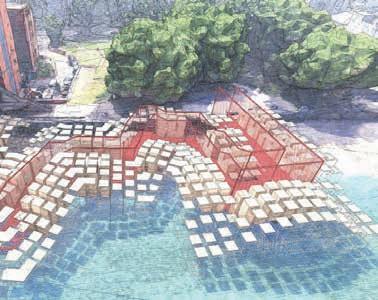
This thesis creates a sensory biophilic experience in which one can be immersed in a lush, vibrant rainforest experience in the middle of Oxford Street, thus heightening the senses and nourishing and refreshing visitors' minds.
Xiaopeng Liang
Historic Alignment: Bargehouse restaurant & bar
Ahmed Khalil Barka
Short Stay Sanctuary: Bargehouse temporary student accommodation
This study proposes a solution to the challenges faced by overseas students first arriving in London. It investigates several layouts of bedrooms and common areas to meet the needs of students arriving in a large city with a limited budget when student accommodation is scarce, and no network of friends.
Yi Wang
Synesthesia: The sound-vision connection

This thesis explores the visual representation of sound, and how it can be enhanced or disrupted by architectural forms. Transforming the entrance to Regent Street Cinema, hanging spatial forms visualise and interact with surrounding sounds, synaesthetically embodying and disrupting sound waves. As a result, the noise and disturbance from the outside world will diminish allowing visitors to complete the emotional transition from the real world to the movie world.
Rebal Khan
Congenial Clusters: Integrative buildings for human activities in a symbiotic ecosystem This thesis proposes single-function buildings should be rejected. By investigating spatial utilisation by various user groups, it draws parallels between human activities and mutual behaviours in nature to establish interconnections and adaptability strategies to create resilient buildings which address the dynamic needs of users over time.
Gunjan Khemka
Last Train Gone: Investigating human postures to shape hanging hotels
This thesis examines daily human routines to inform the design of a comfortable emergency hotel within London's Liverpool Street Station. Drawing inspiration from natural structures like wasps' nests and the station's history as a WW2 shelter, this sleeper city offers safety and solace in the wee hours of uncertainty.
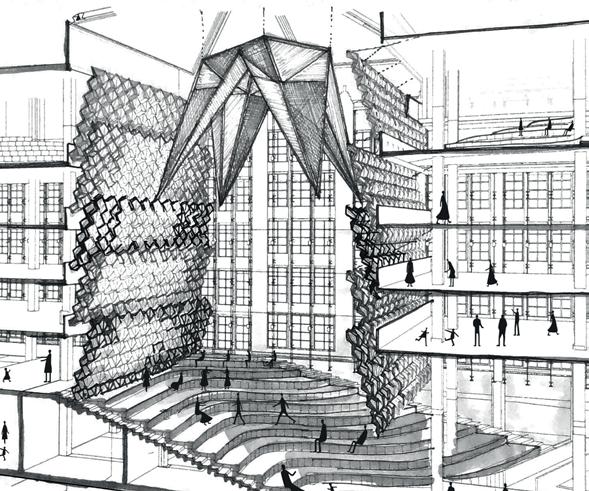
MA Interior Architecture | Masters
(left-right) Rebal Khan; Faezeh Mirzaei; Nishika Diyabalanage ; (top left) Yi Wang
Morvarid Farhoodi
Dancing with light
Derived from the study and analysis of how bodies occupy and move through space, this thesis explores the synergy which exists between people, and the transference of experience between physical and digital models. The recording of a person moving and dancing within an architectural space is transformed into a virtual reality experience, allowing users to engage with the spatial and emotion experience of another.
Prashant Odedara
Co-working Hub
This thesis turns Oxford Street's disused House of Fraser into a shared space with an open central courtyard and natural green spaces for recovering, learning, earning and socialising. It is a place that opens the opportunity for spontaneous conversations with like-minded people; being inspired by each other and being an inspiration for the next generation.
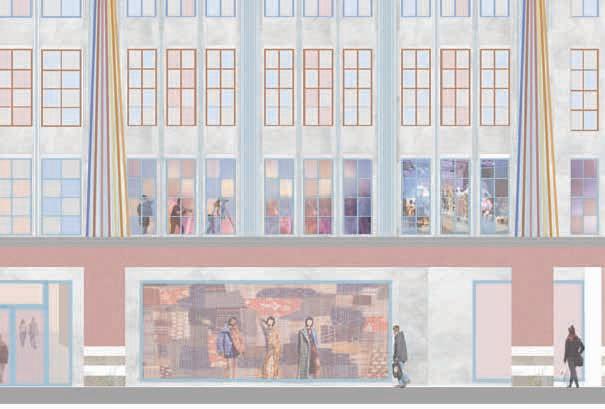
Kayser Khalid
The Loom House
This thesis explores re-imagining and reviving the art of weaving by creating an art centre through an adaptive and creative reuse of The Bargehouse warehouse on London's South Bank, where experts can practice and amateurs can engage in the art form.
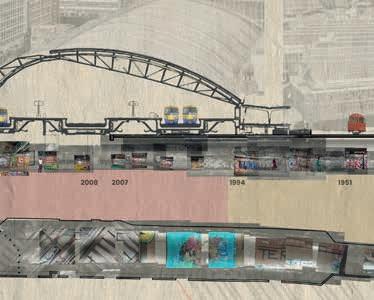
Silvi Pramodbhai Panchal
The Inhabitable Sculpture: Inquiring ambiguity of thresholds
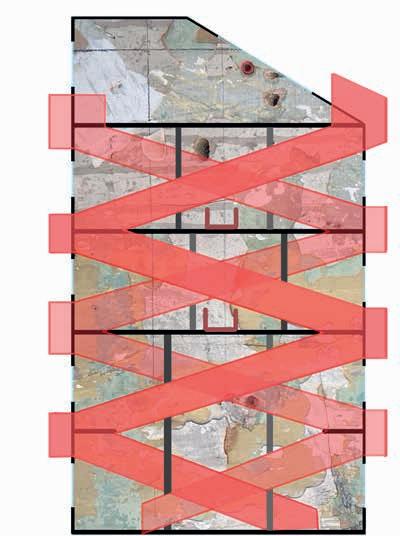
Can thresholds be inhabitable? This project investigates the ambiguity of transitional and in-between spaces. Standing tall at the Ranston Street, the inhabitable sculpture is an abstract, alien-like structure breaking spaces into situations and events. Each plane and element exists to provide opportunity for various household activities.
Senuri Peththawadu
Make Way for Wellness
This thesis sets out to encourage people to step outside their homes and engage with others within their community to avoid social isolation. Drawing from the principles of daily rituals of food shopping, this thesis imagines a community market kit and how it can connect people physically, emotionally and culturally.
Serena Patel
Political Power Clubs: An investigation into women's empowerment
Oxford Street's House of Fraser is re-purposed in this thesis. Designing a new haven for women in politics and power, it proposes a radical transformation of space, responding to the possibilities of women’s voices in a world of tradition and order. By reprogramming the generous voids of the 1920s building with engaging content, a new typological paradigm will form.
Anushka Rahul More
YATRA: A journey into the unknown
Every space is a mystery which tells us a story, making us inquisitive about exploring new ideas along with the context from which they are born. It is a mindful journey that expresses a poem of an inner mind or beyond, an amalgamation of ideas inspiring us with future possibilities.
Aishwarya Ramesh Kumar
Reimagining Productivity: Pioneering the future of creative workspaces
Using the Bargehouse as its canvas, this thesis project envisions the future of creative workspaces, asking: How can architecture enhance productivity and ignite creativity in workspaces? Through architectural ingenuity, the aim is to revitalise the disused building, fostering innovation and creativity.
12 Masters | MA Interior Architecture
MA Interior Architecture theses 2023 contd.
(left-right) Kayser Khalid; Alveena Zahid; Pallav Kapoor
Pallav Kapoor
Layered Landscapes: Tracing history, time and graffiti at Leake Street Arches

The thesis investigates the sedimentation of time, from the microscopic to macro-urban scale by peeling back the layers of history, paint and artefact found in London's longest legal graffiti tunnel. Through archival research, chromatography and photogrammetry, the research documents and represents the ephemeral qualities of the tunnel through a temporary installation.
Jinglu Ruan
The Bird's Nest
This thesis addresses the limited availability of affordable housing in London. It considers the creation of a vertical residential community for young people just starting their careers at a site in central London. In addition to the infrastructure of the apartment building and ‘home’, the building facilitates social spaces for residents.

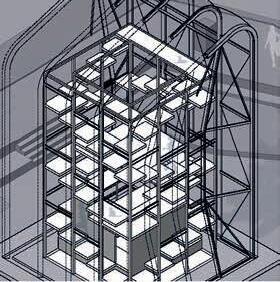


Shenon D'Costa
Unaccounted Traces: Investigating the intangible traces of Down Street Station
The thesis proposes a technique for capturing the intangible markings on the soot-covered walls of the disused Down Street Station using cyanotype prints, contrast mapping with Rhino 3D-modelling and fabric layering. It renders visible how a space is touched by the people living in it or passing through it.

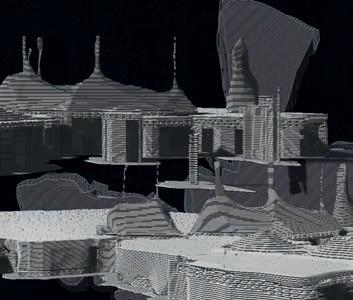
Zhe Sun



New Birth of a Church Ruin
This thesis investigates constructing new functions for a church ruin located in central London, encouraging more people to visit and explore it, while allowing both its sacred and historic elements to exist. It considers how modern architecture can frame and enhance abandoned churches within cities.
Iveta Hanzenova
VerdureSanctum: Nurturing nature within
This thesis proposes transforming London's House of Fraser into a captivating nature-immersed haven. The structure cultivates thriving ecosystems, where architecture harmonises with abundant green landscapes, nurturing the relationship between humans and the natural world and offering an escape from the bustling city, providing a vital connection to nature.
Nithya Shree Viswanathan
Infinite Echoes: Mirroring the legacy of the Bargehouse



The thesis explores the metamorphosis of Bargehouse into an engaging cultural hub by blending history, community engagement and innovative design. It celebrates the past, evokes nostalgia and fosters connections through immersive experiences, art and reflection, enriching collective memory.

Fateme Toofany
Playing The Bargehouse
This thesis transforms the Bargehouse into an interactive architectural instrument, blending art and sound. Musical elements which function architecturally invite visitors to ‘play’ the building, creating collaborative soundscapes while illuminating the synergy between architecture and music on London's South Bank.
Alveena Zahid
Threads of Revival: Integrating sustainability and culture into urban renewal

In a state of metamorphosis, Oxford Street's defunct House of Fraser is awakened as Kintsugi's grace and wabi-sabi's wisdom turn flaws into art. This thesis imagines the former department store becoming a haven for renewal in the hands of social creators and designers. The antithesis of fast fashion, it embodies a mindful shift to former crafts of repair and redesign.

MA Interior Architecture | Masters
(left-right) Nithya Shree Viswanathan; Silvi Panchal; Ma Aleinna Majan Gonzales Almukhaini ; (top right) Shenon D'Costa
0 500 1000 2500 MM
Nasser Golzari (Course Leader), Andrew Carr, Beth Cullen, Davide Deriu, Prajakta Kalamkar, Iman Keaik, Krystallia Kamvasinou, Dirk Lellau, Maja Jovic, Samir Pandya, Yara Sharif, Adriana Useche, Filip Visnjic
Nasser Golzari is a senior lecturer and senior partner of Golzari (NG) Architects. His research and build projects have won a number of awards including RIBA Award for Research, Holcim Award and Aga Khan Award.
Krystallia Kamvasinou is a senior lecturer, an architect and a landscape architect. Her research on the topic of Interim Spaces and Creative Use has been published widely in academic journals and books.
Yara Sharif is a practicing architect, senior lecturer and partner at NG Architects. Her work reframes architectural practice while exploring contested landscapes. Her book Architecture of Resistance and collaborative work with PART won the RIBA President’s Award for Research.
Filip Visnjic is an architect, curator and a media technologist working at the intersections of art, media and technology. He is editor-in-chief at CreativeApplications.Net, and director at HOLO Magazine
MA Architecture
Students: Dalya Abdulwahhab, Sara Al-Araj, Melcenur Aldemir, Behnam
THE ARCHITECTURE MA course offers a dynamic and unique programme on advanced postgraduate study, combining a high level of design and theoretical investigation with innovative representational methods and critical approaches to contemporary discourses on the subjects of design and theory. The programme is holistic, encouraging strategic re-thinking of habitation at the scale of the city/neighbourhood. Taking theories and design practices in socio-environmental ecologies or issues of globalisation and identity into consideration, students engage in conceptual and technical explorations of redesigning habitation at macro- and micro-scales.
The different modules on offer encourage alternative modes of study and creative methods in design, representation and research. MA Architecture allows for
specialisation in architecture design or theory through its three pathways: Cultural Identity and Globalisation; Digital Media; and History and Theory. Alternatively, there is an option for students to select and combine relevant modules that meet their personal interests for their career development, if they decide to take the two-year poststudy visa option of working in the UK and beyond.
The course also offers distinct student awards, including Jila Golzari for outstanding achievement in one academic year, and Weston Williamson + Partners for outstanding Thesis Design offering monetary and working in practice prizes; and Surjit Cheema Award, for the most outstanding and creative piece of writing. The awards are announced at the exhibition marking the end of the academic year.
Guest Critics:
Philip Breese, Danilo Bulatovic, Simon Cole, Richard Difford, Deniz Çetin, Prajakta Kalamkar, Charlotte Khatso, Katarzyna-Kasia Kwiatkowska, Mirna Pedalo, Adriana Useche
14 Masters | MA Architecture
Azadfar, Lloyd Butcher, Ekin Arca Cavusoglu, Tsz Pan Cheng, Else Elizalde, Simay Fidan, Francesca Gabri, Nuha Imran, Zhiguang Jin, Julia Knapek,
Nekesh Maharajan, Lakshita Mohta, Vrushali Nazarkar, Ali Sardar Ozadam, Sara Rraja, Nastaran Sabzehali, Kristin Sharpe, Sakshi Pravin Sonigara, Shiraz Vir Singh, Mara Von Kymmel, Yijie Wang, Jobayer Ullah
TszPan Cheng Choi Hung Home
DRAWING FROM THE art form of ancient Chinese paintings, this thesis considers how to build a state of equality and harmony between men and women by challenging traditional concepts of ‘home’ and re-creating a modern vision of it.

Male superiority over females was an explicit part of ancient Chinese culture, and such a phenomenon had a great impact on the survival and development of women. During the 2,000-year-long feudal society, women as a group did not have an independent personality, and they were subject to the constraints of the patriarchal system, feudal rituals and the persecution of the concept of chastity.
By studying different Chinese ancient paintings about Chinese home culture and comparing to contemporary society, it can be seen that although male superiority over women is still present, there are changes taking place.
The Chinese home culture has always been considered the warmest and most secure by Chinese people, and in response the thesis incorporates elements of Chinese architectural, mutual equality and harmony, promoting the creation of a place where people feel included. The research project aims to create homes and communities with strong Chinese elements, to increase the sense of intimacy for the elderly, and allow those who live in the same area to be closer to each other to meet the psychological need for companionship.
The thesis project intends to build a state of equality and harmony between men and women, centred on the concept of home, where everyone lives together in harmony and equality as a family. The project is to paint home culture with personal knowledge of ancient Chinese paintings and to paint a different kind of home from the ancient Chinese period, i.e. gender equality.
MA Architecture | Masters
Sara Al-Aaraj Environmental Archives: Investigating the cultural legacy of extracted earth
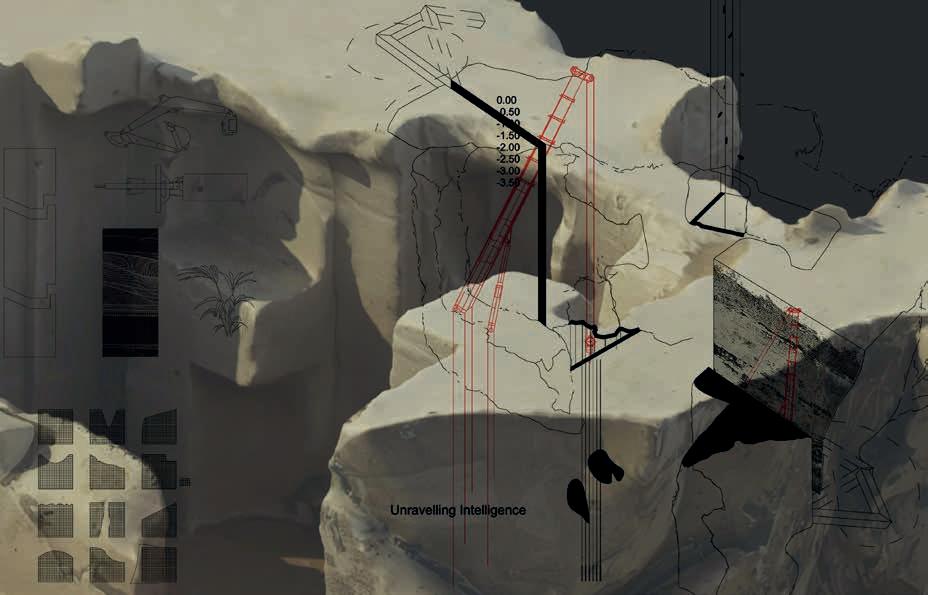
SOIL IS A RESOURCE that's often overlooked, or used abundantly without consideration; culturally treated as infinite. This thesis turns the spotlight on soil, speculating on it as a medium of continuity and archiving, preserving previous cultural practices. It’s a witness to the past and simultaneously offers a glimpse into possible futures.
Through digital media, this project frames soil as a living substance that needs to be nurtured like any crop, and is vulnerable to depletion and degradation through misuse. It considers how the earth we extract from the ground is a material with a narrative embedded within it. It’s a legacy, a treasured possession that should be valued and celebrated rather than neglected.
The thesis argues that in reaction to the mutations witnessed in land, climate and atmosphere as a consequence of the Anthropocene, entanglement between humans and nonhumans needs to be addressed to overcome the ideology of exceptionalism of the human race over all other beings – .
This ideology challenges the way we think about the environment as a field of separate entities each working on their own, but rather sets a framework to think about the environment as an interconnected system. Therefore, extractive processes are analysed and foregrounded as explicit evidence of how consumed and overexploited our environment has become, and consequently, raise empathy towards our relationship with the ground beneath us.
16 Masters | MA Architecture
Dalya Abdulwahhab Echo through time: Erbil Citadel's legacy and the preservation paradox
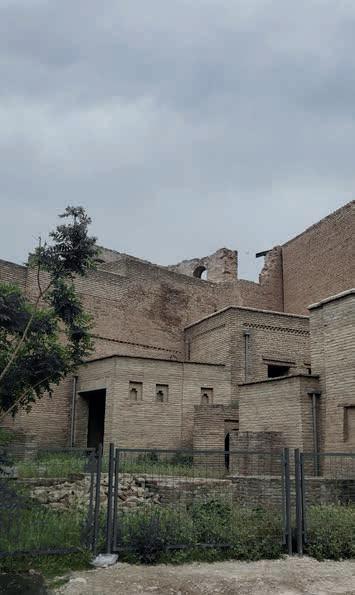
THIS THESIS EXPLORES the intricate links between heritage preservation, cultural identities, and a local community's connection to its history. The Erbil Citadel, situated in the Kurdistan region of northern Iraq, serves as the primary case study. As a UNESCO World Heritage Site, the Citadel holds immense cultural importance for the Kurdish populace, who have faced oppression and invasion throughout history.
Although preservation efforts have been aimed at safeguarding the physical fabric of the Citadel, local officials have limited access to the site in order to have it listed as part of UNESCO's world heritage. As a consequence, this restriction on the site has led to a disconnection
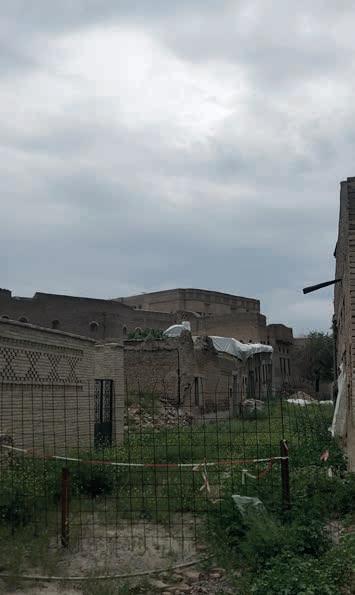
between Erbil's residents and their shared past. The thesis investigates the impact of heritage preservation policies on the cultural identity of the Kurdish community, with a particular emphasis on the historical roots that are in danger of being lost.
It sheds light on the paradoxical nature of architectural preservation and its effect on the oppressed Kurdish minority, using various qualitative research methods, including interviews, as well as a range of primary and secondary materials. The study's findings contribute to the broader theme of preservation and highlight the importance of including intangible elements of cultural tradition in such endeavours.

MA Architecture | Masters
MA Architecture theses 2023 contd.
Melcenur Aldemir Synergy Seascape: A rediscovery of identity in Izmir Konak Square
Inspired by Italo Calvino's Cosmicomics, this project explores the consequences of rampant urbanisation and human greed in a fictionalised narrative of nature's revenge and subsequent healing of Izmir.
Ekin Arca Cavusoglu
Hypermaze as a Habitat for the New Era
Amplifying the design of a subterranean system inside the river Thames, the thesis imagines the inhabitants of London being relocated into underground shelters that are fragmented in a poly-rhythmic layout due to a catastrophic event that sets a dystopian reality.
Francesca Garbi
Finding Harmony between Past and Present: Adaptive reuse of historic buildings
This thesis analyses the adaptive reuse strategy used to transform historic Italian buildings into art galleries. It aims to evaluate its success at re-evaluating existing structures to prevent building decay or demolition.
Zhiguang Jin City Re-Imagined: Sharjah's twin world
This thesis sets up a theatrical ‘twin world’ to zoom in and exaggerate the phenomenon of wealth inequality of residents in Sharjah City. Comparing exaggerated versions of wealth creation and distribution within this oil-rich city, the thesis projects the implosion of this fictionalised scenario.

Behnam Azadfar Tehran Open University: Development through the Three Ecologies criteria
This thesis takes the idea of the Fourth Wall as a metaphor to tear down barriers and create an open university to life to bridge social, economic and environmental conditions in public spheres of Tehran.
Else Elizalde
De-centred Agriculture: Exploitation, colonisation and representation
Drawing on theory from James Corner to analyse landscapes through mapping, this thesis explores the historic and contemporary exploitation of land acquisition as a tool of power through colonialism and manipulated in the name of material profits.
Nuha Imran Topography of an Imagined Future
Delving into Riyadh's memory, this thesis considers a parafictional landscape that examines the city's urban developments and new aesthetics whilst exploring its ruins, displacement and erasure; a topography to remember and freeze the present city as it aspires to become a top global economy.
Nekesh Maharajan
xx xx
This thesis aims to connect the neglected parts of Kathmandu while addressing the needs of the Newar communities native to the valley by connecting different parts of the city with spaces designed to revive Newari culture and traditions.
Lloyd Butcher
Reactive Form in Opposition to Proactive Architectural Norms
Grounded in queer theory, this thesis seeks to establish reciprocity between subject and object to create deviant morphologies to destabilise socio-spatial norms which often deny, reduce and manipulate non-conforming persons and communities.
Simay Fidan Reviving the Forgotten Collective: An urban experience
This thesis aims to revive a forgotten collective culture by redesigning cultural heritage buildings in three zones: Functional, Art District and Food District, reinterpreting the ideal city.

Knapek Gasthaus
This project delves into deductive architecture, reimagining the concept of a Gasthaus with a sustainable and holistic vision. Prioritising a sense of belonging, wellbeing and comfort while preserving cultural heritage, it aims to harmonise modern development with historical preservation.
Lakshita
Mohta
Ephemeral Reminiscence: The evocative nature of St Dunstan in the East
This thesis delves into how collective memory evolves over time by exploring the dynamic relationship between memory, architecture and history in this transformed church, revealing architecture's enduring essence amidst temporal change.
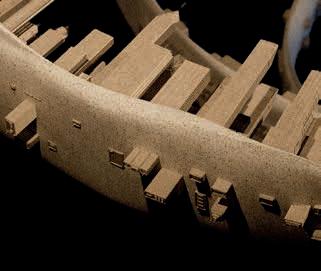
18 Masters | MA Architecture
(left-right) Nekesh Maharjan; Shiraz Vir Singh; Zhiguang Jin
Julia
Vrushali Nazarkar
Endangered Urban Forest: A case study on Aarey Forest
This thesis investigates the ecological, social and environmental challenges to the conservation and sustainable management of Aarey Forest, ‘the green lungs of Mumbai’, and proposes strategies to protect endangered urban forests amid urbanisation pressures.
Kristin Sharpe
Bricks and Morals: The production of space at the University of Virginia

This thesis explores the production of space at the University of Virginia's academic village, focusing specifically on the dynamics that constitute ‘The Lawn’ through a combination of historical research, empirical observation and reflections on lived experience.
Mara Von Kymmel
Rives Vertes: Redefining algae as a
sustainable building material




This thesis seeks to re-evaluate perception of algal overgrowth in Lac d’Echternach by transforming it into algae-infused clay bricks to foster connections between locals and the natural environment, while promoting regenerative sustainability in the built environment.
Ali Serdar Ozadam
Revealing Invisible Boundary Patterns: The role of time, body and interactions

Focusing on Istiklal Street, this thesis investigates boundaries, emphasising time and body interactions. It aims to develop a system diagram through research, case studies and rules-as-patterns to reveal concealed behavioural patterns and interactions.
Shiraz Vir Singh Re(Claiming) Horizons

Centred on areas of London where towering skyscrapers symbolise capitalism's opulence, this design thesis envisions a future characterised by de-growth and explores a transformative narrative where residents collaborate to craft a post-capitalist utopia reclaiming the very essence of these structures.
Yijie Wang Memory & Cognition of Longchang Apartment
The project takes the rapid urban development of Shanghai as the background, and attempts to record memory and cognition of a community where Longchang Apartment is the main body, in the form of digital assets.
Sara Rraja
Landscapes in Motion: Topological representation of walking in urban spaces

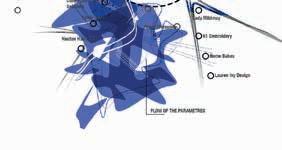
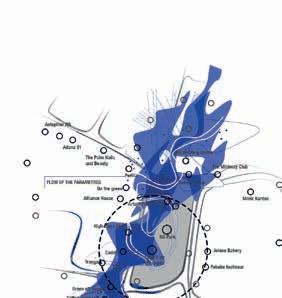

Focusing on Newington Green, this thesis investigates how walking in urban environments fosters transient spaces shaped by individuals' interactions with architecture, urban furniture and inhabitants within the broader network of the city's topological fabric.
Sakshi Pravin Sonigara
Rethinking Informal Settlements: The livework units of Dharavi, Mumbai, India
This thesis considers the redevelopment of Dharavi, Mumbai. It explores the role live-work units play in the social capital of an informal settlement, reasons for contestation, and how their integration contributes to local livelihoods to create sustainable community.

MA Architecture | Masters
(clockwise from top left) Ali Serdar Ozadam; Sara Rraja; Lloyd Butcher; Kristin Sharpe; Nuha Imran
Rosa Schiano-Phan (Course Leader), Mehrdad Borna, Paolo Cascone, Joana Goncalves, Kartikeya Rajput, Filomena Russo, Rofayda Salem, Vera Sarioglu, Amedeo Scofone, Juan Vallejo
Juan Vallejo is an architect and environmental design consultant working and teaching internationally between Spain, Italy and the UK. Juan’s expertise lies in the field of building performance simulation, natural ventilation and passive cooling.
Filomena Russo is a doctoral researcher with a MPhil degree in Environmental Design in Architecture from the University of Cambridge. She is a registered qualified architect in Brazil and the UK, and has practiced sustainable architecture in the UK and internationally.
MSc Architecture and Environmental Design
Mathieu Naccarato, Esther Onabanjo, Yashkumar Patel, Srushti Pawade, Przemyslaw Piotrowicz, Nidhi Shreya Prabhakaran, Soma Rahem, Aishwaryasree Sivashanmugasundaram, Xin Thong Tan, Anju Thomas, Xiaoqing Xu
IN 2022/23 THE Architecture and Environmental Design
MSc was part of the Cross Disciplinary Exchange Project across the School’s PG courses and investigated the environmental performance of Living Environments, with an emphasis on social housing in central London. The study investigated work and live environments in the Church Street housing development in the London Borough of Westminster in the context of its climate, urban microclimate, architectural features and occupants’ behaviour. The analysis explored the mutual effects that such factors have on indoor/outdoor activities, environmental quality, human comfort and energy consumption in buildings. These evaluation projects led to the semester 2 design brief on ‘Environmental Retrofit in the Changing Climate’. Proposals for the retrofit and re-imagination of the studied site were offered by the
students with attention to the compounding requirements of social housing, energy crisis, climate change and resources conservation.
The course successfully continues the Collaborative Thesis Programme with Industry partnering with a range of architectural firms and environmental consultancies. To date theses feature a variety of topics in different climatic and socio-political contexts. The MSc AED embeds the BREEAM Approved Graduate course, while being Learning Affiliate with the Energy Institute. Since April 2022, the course has also received conditional accreditation by the Chartered Institute of Building Services Engineers and the Energy Institute. These initiatives have led to joint publications with our alumni and employment opportunities for our students.
Special Thanks:
Guest Critics:
Jack Penford Baker (Haptic Architect) ,
Jennifer Juritz (DMA) , Matthew Marson (JLL) ,
Hrabrina Nikolova (Westminster City Council) , Sal Wilson (AA)
Hamza Alhalabi (WSP) , Dimitris Argyros (Haptic Architects) , Herman Calleja (SOM) , Justina Caputo (WSP) , M J Daccache (Hilson Moran) , Stephanie Del Mel (WCC) , Christian Dimbleby (Architype) , Lachlan Fahy (Terracool) , Catherine Harrington (Architype) , Dean Hawkes (University of Cambridge) , Patrik Hermon (LCD) , Sioned Holland (Architype) , Moha-taz Hossain, Brenda Kim (Marks Barfield Architects) , Phil McIlwain (Stroma) , Andrew Moore (Hilson Moran) , Harry Sumner (Haptic Architects) , Dilara Temel (Terracool)
Agrawal, Mathieu Naccarato: Church
20
Masters | MSc Architecture and Environmental Design
Aditi
Students: Aminu Abubakar, Aditi Agrawal, Oghenesiri Akpofure, Agostino Anselmo, Abhishek Prashant Bholagir, Maria Degetau, Lama El Ayache, Arfa Farookh, Noel George James, Abid Abdul Karim, Neha Dinesh Khilare, Raymund Laurel, Himabindu Mannava, Vinoth Muthusamy, Street Housing
reimagined
Rosa Schiano-Phan is Reader who has worked in environmental design consultancy and research for almost 25 years. Rosa is the co-director of the Centre for the Study of the Production of the Built Environment (ProBE) and has lectured and researched internationally.
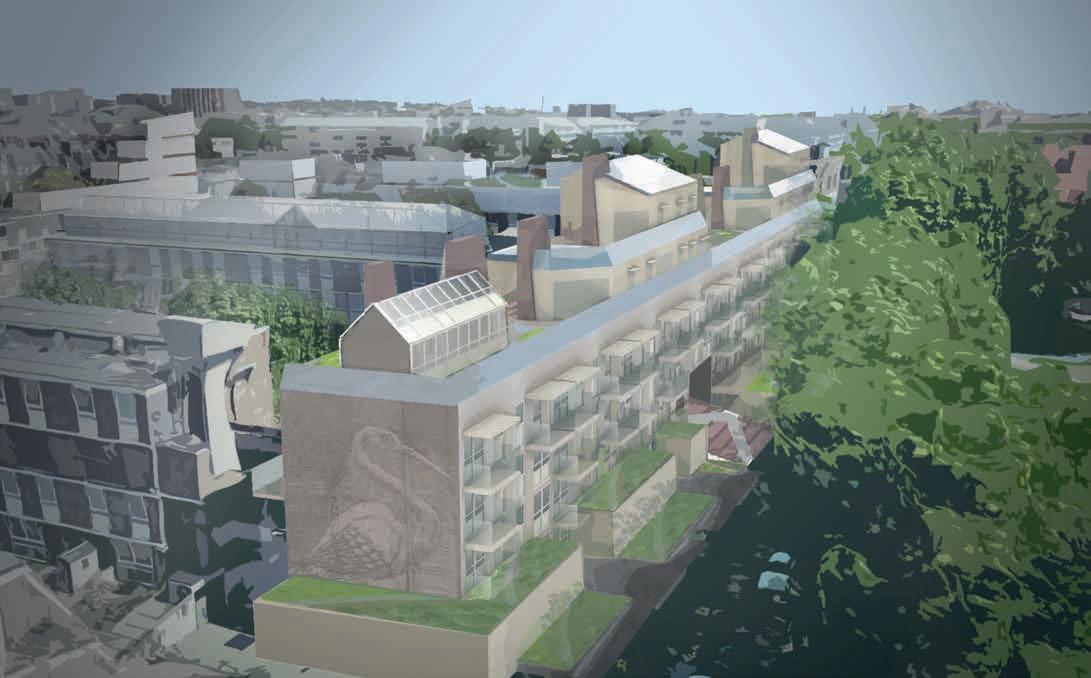



MSc Architecture and Environmental Design | Masters
Aditi Agrawal Roof Daylighting for Visual Comfort in Museums:

Daylight strategies for preserving artworks while enhancing the visitor experience
MUSEUMS PLAY A crucial role in preserving and displaying cultural artefacts. It can consume significant amounts of energy to maintain an internal environment. The use of lighting accounts for 20% of this energy consumption. Museums generally operate on a 10:00 to 17:00 hour cycle. Hence, incorporating carbon- and cost-free daylight is imperative for creating a low-energy museum.
However, the idea of lighting a museum with daylight resonates as a complex concept. The research is undertaken with three distinct and applicable case studies based in London to help understand the use of daylight to its maximum potential. The primary case study, Victoria and Albert Museum, is selected for its varied daylight spaces. Useful Daylight Illuminance (UDI) tests are carried out for the entire year, but with the help of a typical sunny summer day, the study evaluates the extremities of light in a day and the impact of roof daylighting on visual comfort. It brings along the intangible complexities in a space which include user experience, perception and visual comfort, investigated through designed questionnaires, observations at site visits and calibration of luminance levels respectively. Based on literature reviews, fieldwork and the comparison of simulation results and iterations, this work proposes design recommendations for optimised space dimensions of museums, roof types and their glazing ratios, and brightness and contrast values.
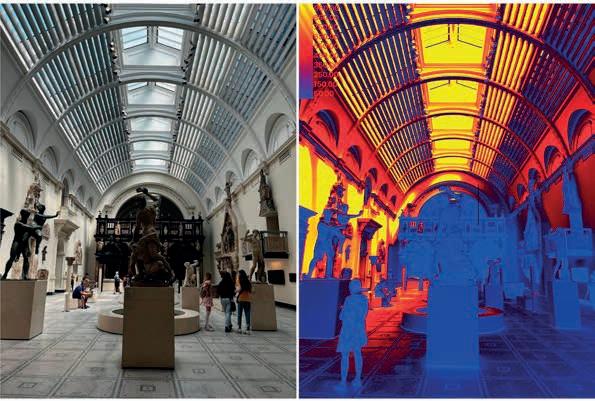
The research concludes the implementation of an adaptable hybrid roof daylighting strategy is pragmatic for preserving artworks while enhancing the visitor experience.

22
Masters | MSc Architecture and Environmental Design
(left) Solar geometry of Victoria and Albert Museum gallery roof according to the seasons in London's climate; (right) Luminance render of gallery and exhibits in Victoria and Albert Museum in different conditions
Maria Degetau Environmental design system for a Maasai educational building





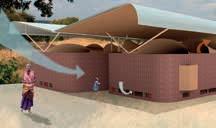
THE PROPOSED EDUCATIONAL design thesis aims to protect the environment as well as the native culture of the Maasai people in the northern area of Tanzania. It is a project proposed and fought for by the community, where many generations have come together to think about how they want their future to be.


Affected by global climatic changes, Tanzania is one of the many countries near the equator that will suffer a dangerous temperature rise, directly threatening life and therefore the region’s culture and traditions.



Future predictions see the local climate changing to tropical savannah. Starting from a detailed study of vernacular African building techniques a precedent is set to inform the design of this research. Appropriate passive strategies for this type of climate are adopted to achieve maximum comfort.








A holistic programme is proposed to take into consideration women's modern role without forgetting traditional and vital responsibilities, such as the provision of water and quality education.


The existing gender inequality gap, exacerbated by climate change, was addressed by refocusing the harvested rainwater supply into the centre of the community and therefore into the building. Consequently, the building will take its form, applying all the relevant environmental strategies to achieve comfort throughout the year and most importantly throughout the warmer seasons of the future.

The project was based on on-site fieldwork and community participation, allowing learning about traditions which informed the project and development of tailored solutions to meet the changing needs of Orkisima's Maasai community.
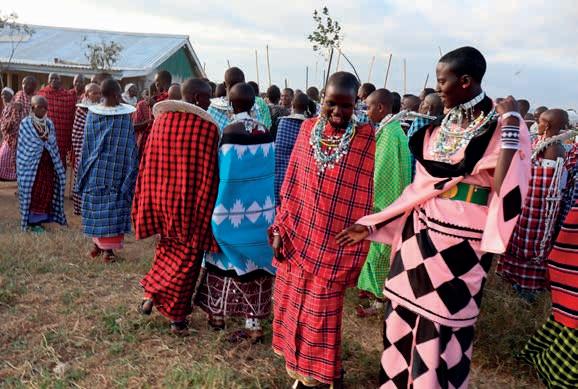


MSc Architecture and Environmental Design | Masters
(left) Environmental strategy section; (right) Prototype model, winter solstice
MSc Architecture and Environmental Design theses 2023 contd.
Aminu Abubakar
Healthcare Facility at Kwarin Zurmi, Nigeria
Focusing on the design of healthcare facilities in extreme climatic conditions in Nigeria, this research examines how to build a sustainable, climateresponsive building that satisfies the community's demands and overcome the lack of vital services.
Abhishek-Prashant Bholagir
Strategies to improve outdoor thermal comfort of urban canyons in hot and arid climates
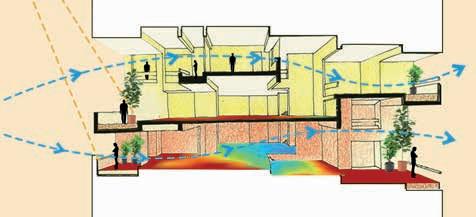
Focusing on hot and arid climates, this research aims to improve microclimatic conditions of urban spaces like street canyons, by implementing various strategies to achieve outdoor thermal comfort for pedestrians.
Noel George James
Overheating assessment methods for new residential developments
Focusing on residential buildings, this thesis explores key aspects of the CIBSE TM59 overheating assessment method and its significance in mitigating risks of overheating in the UK.
Raymund Laurel
The impact of green walls on air pollution and thermal comfort in street canyons
This research evaluates the effectiveness of green walls in mitigating air pollution and temperature increases during the summer in cities, as millions of people in urban areas are severely affected.
Oghenesiri Akpofure
Flood-Resilient Housing and Environment for the Urban Community – Nembe, Nigeria
Working with indigenous technologies, environmental simulations and digital prototyping, this thesis considers how to build affordable self-sufficient housing solutions which are also flood-resilient within the African context.
Lama Elayache
Whole Life Carbon Assessment: Unveiling the uncertainties of the carbon journey
Whole Life Carbon Assessment is essential to evaluate carbon emissions in building projects, but there are uncertainties about accuracy and comparability. This research analyses and provides ranges to quantify it.
Abid Abdul Karim
Enhancing HVAC Systems of high-rise office buildings in the UK
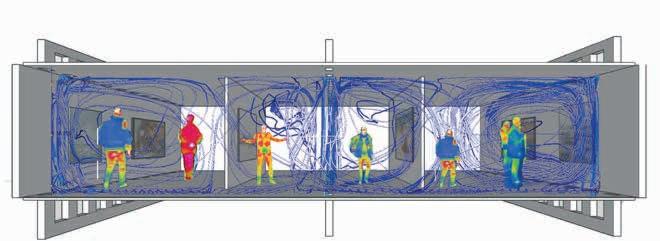
Focusing on high-rise office buildings' energy-intensive nature, this research considers solutions to HVAC systems tailored to the specific climatic conditions of the UK, and projecting towards net-zero consumption.
Himabindu Mannava
Overheating optimisation of commercial buildings in London for large glazed façades
This thesis analyses how solar control and passive cooling techniques could be optimised to minimise the risk of overheating in large glazed commercial buildings, and considers how to integrate them in façade designs.
Agostino Anselmo
Timber Solutions for Carbon Reduction: The impact of mass timber construction
This research considers how a carbon-conscious approach to building with mass timber can deliver significant reductions to a building's whole life cycle greenhouse gas emissions, beyond the embodied phase.
Arfa
Farookh
The impact on embodied carbon from locallysourced timber external wall systems
This thesis considers how using locally-sourced timber as cladding and insulation could reduce the embodied operational carbon of buildings to be in line with the 2050 net-zero target set by the U.K.
Neha Dinesh Khilare
Understanding the correlation between lux levels and overheating in high-rise buildings
Using the Kanchenjunga apartment building, Mumbai, as a case study, this paper evaluates correlations between daylight and overheating in high-rise buildings, and develops strategies to mitigate and balance them.
Vinoth Muthusamy
Operational Energy: Pathway to net zero carbon in later-living homes
This study examines and identifies the key factors influencing energy use in retirement homes and develops a methodology and architectural standards to achieve net-zero carbon operational energy.
24 Masters | MSc Architecture and Environmental Design
(left-right) Neha Khilare; Srushti Pawade
Mathieu Naccarato
Low embodied carbon ventilation systems for healthy learning spaces

Passive systems are well known for their potential to reduce operational energy, but less is known about their embodied carbon. This research provides a comparative analysis of ventilation systems in temperate climates.
Srushti Pawade
Displacement ventilation for energy efficiency in museums and art galleries
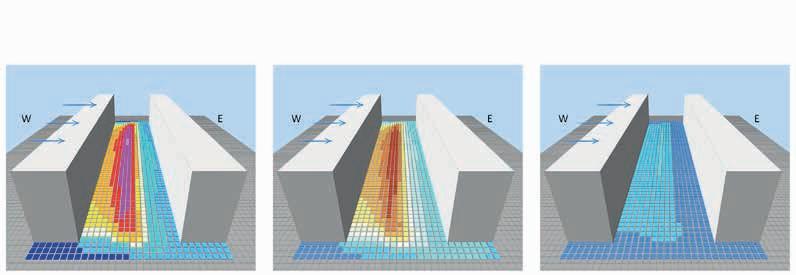
Taking predetermined environmental conditions for both exhibits and visitors into consideration, this thesis analyses displacement ventilation strategies in galleries which significantly reduce energy consumption.
Soma Rahem
Evaluating the environmental impact of retrofit of 1970s office
buildings
Retrofitting 1970s office buildings in London is crucial for addressing issues of overheating and energy demand. This research evaluates the impact of external dynamic solar shading on operational energy and visual performance in commercial buildings.
Anju Thomas
Material Flow Analysis of recycled concrete aggregates in the City of Westminster
Using a Material Flow Analysis of recycled concrete aggregates within the city of Westminster, this thesis analyses how increased RCA use reduces waste and resource extraction, fostering a circular economy.
Esther Onabanjo
Assisted elderly living design in Ijebu Ife, Nigeria, Africa
Nigeria is experiencing rapid growth in the aging population. This project aims to design sustainable assisted elderly living in Ijebu Ife, Nigeria, incorporating eco-friendly practices and promoting well-being.
Przemyslaw Piotrowicz
Off-grid energy in EnerPHit retrofit residential buildings
Complete off-grid energy provision is rarely considered within retrofitted dwellings. This study evaluates the strategies required to achieve this whilst meeting the EnerPHit passivhaus energy criteria.
Aishwaryasree Sivashanmugasundaram
Embodied carbon associated with overheating strategies
This research aims to identify strategies to reduce embodied carbon through building façade materials and address the impact of overheating in a London community learning space.
Xiaoqing Xu
The Study of smart building design and its sustainability
By analysing the energy consumption of a case study office space, this study explores different methods for smart building design in commercial buildings, considering both energy savings and user satisfaction.
Yashkumar Patel
Circular Economy: Challenges and opportunities of recycled concrete aggregates
This thesis considers the challenges and opportunities for sustainable construction when using 100% recycled concrete aggregates, minimising waste and resource depletion while maximising value of existing materials.
Nidhi Shreya Prabhakaran
Adaptive Skins: Efficiency of dynamically responsive façades in commercial buildings
This research analyses the impact of light-responsive dynamic architectural façades in Dubai's commercial buildings on energy demand, carbon footprint and performance, evaluating their sustainability optimisation.
Xin-Thong Tan
Living with Floods: Innovative architecture for flood-prone locations
Floods pose a significant threat to buildings worldwide, and climate change exacerbates the situation. Focusing on Malaysia, this thesis proposes innovative designs and flexible planning for flood-prone areas to mitigate the impact on people's lives.


MSc Architecture and Environmental Design | Masters
(left-right) Raymund Laurel; Oghenesiri Akpofure ; (top right) Esther Onabanjo
David Mathewson, Krystallia Kamvasinou, Simone Gobber, Luz Navarro, Simona Palmieri, David Seex, Louise Thomas
David Mathewson is a Senior Lecturer, with over 20 years' experience as an urban designer, architectural designer and international planner currently undertaking doctoral studies in planning policy related to flooding and the link with changing urban form in Jakarta, Indonesia.
MA Urban Design
Students: Nick Brown, Sara Campos Salorzano, Lauren Cook, Kieran Easton, Purvi Golecha, Dina Ibrahim, Nicola Jurkiewicz, Mugel Khalafalla, Taylor MacDonald-Plummer, Madiha, Marc Messmer, Natasha Muhammad
Razib, Vrushi Pravinkumar Patel, Neha Patil, Janhavi Patil, Kamatchi Nivashini
Ragaswamy Ganeshkumar, Dipu Sherathiya, Büşra Sönmez
THE PG URBAN DESIGN course, with MA, Diploma and Certificate Pathways at the University of Westminster provides a coherent approach to understanding and studying the challenges facing cities today. Combining structured academic study with live design projects, it allows students to develop practical skills alongside a theoretical understanding and an informed approach to sustainable urban development. As a multidisciplinary field, Urban Design overlaps with and incorporates elements of urban and regional planning, architecture, landscape design, urban regeneration, geography, transport planning and infrastructure planning, drawing students from all these backgrounds.
Cities are at the centre of modern life and are the places where the majority of the world’s inhabitants make their homes. They are the hubs of economic and social life and where the majority of resources are consumed. They have evolved over time with important city images, built forms and urban profiles that attract investment while serving as cultural assets which reflect the values of their inhabitants, around whom shared experiences revolve and daily activities are shaped. This process is well understood in the West; however, in a global context the pace of
Part-time students: David Batchelor, Tony Beaman, Adam Fall, Karla Johnson, Katherine Keyes, Chris Penny, Nomai Thompson-Cox, Karolien Yperman, ‘Kate ‘ Leuk Ki Yung
change is both dramatic and accelerating, creating new challenges for city design and management, particularly in the developing nations of the global south.
Drawing on the cultural and economic forces acting in the city, the urban design course focuses on understanding and shaping the physical setting in which these processes take place; it carefully considers the manner in which buildings, streets and urban spaces are combined to create distinct environments that nurture daily life, provide efficient urban systems, and form memorable places valued by their inhabitants.
The work presented here is based on student dissertations and major design projects in which particular impacts on the city design are identified and how, in the light of these effects, urban form can best be adapted to current and future needs. The practice of urban design has been emerging as a distinct profession globally since the 1970s and is underpinned by a growing knowledge-base informed by research and tested through spatial analysis and design proposal; these studies represent a critique of current responses to urban challenges and provide a unique contribution to urbanism’s body of knowledge.
Dissertation Tutors: Andrew Boughton, Jeff Howard, Ripin Kalra, Sebastian Loew, Isabel McCagg, Federico Redin, Abubokkar Siddiki, Ian Simpson, Mireille Tchapi
Design Critics and External Contributors: Karan Bakre (Grimshaw) , Nick Bidgelow (LDA) , Odysseas Diakakis (Prior + Partners) , Evgeny Didorenko (LDA) , Cecily Eckhardt de Eckenfeld (Diamond + Schmitt Architects, Toronto) , James Gross (Urban Place Lab) , Nicola Longland (LDA) , Juan Oyarbide (Prior + Partners) , Mark Williams (LDA) , Marcus Wilshere (The Collaborative City) , Felix Yates (Prior + Partners)
26 Masters | MA Urban Design
Büşra Sönmez


MA Urban Design | Masters
MA Urban Design theses 2023
Nicholas Brown
Mind the Gap: The incongruences between conceived streets and lived streets

A study applying Henri Lefebvre’s theory of the Production of Space to the relationship between the street as conceived by London councils' ‘Liveable Street’ strategies and the street as perceived by the people who experience them.

Sara Campos Solorzano
Urban Design and Refugee integration with Cities as Prime Gateways: The case study of Rinkeby, Stockholm
Integration in urban design is the way refugees learn how to use their new surroundings; in what manner they impact and connect to the neighbourhood that already exists; and how they discover how to navigate resources and social dynamics. The research observes, identifies and analyses this process in Rinkeby, Stockholm.
Lauren
Cook
Designing for the Fourth Space: Design principles for an increasingly digitised world
This dissertation explores the changes in how we utilise physical space as a result of increased reliance on internet and online spaces to carry out daily functions, using the COVID-19 pandemic as a lens for investigation.
Nicola
Jurkiewicz
How can modern public spaces be designed for urban dance performances?
This master’s thesis studies the design factors of public spaces used by street dance performers. It aims to fill the knowledge gap of what makes a successful public performance space for dance through the development of a general design code.
Kieran Easton
What gives Peckham its ‘Peckham-ness’? A study of urban character and place identity on Rye Lane


A comprehensive study looking into how best local character and place identity can be retained and enhanced as large-scale new development come forward. The thesis also recommends design principles for how the forthcoming Aylesham Centre proposals should respond to Rye Lane's rich character and place identity.
Dina Ibrahim
The Intersection of Road Design and Public Space: The role of road design in enhancing public space quality in urban areas
This thesis investigates the impact of road design on the quality and liveability of public spaces in urban areas. By analysing three case studies and conducting a literature review, it offers valuable insights for creating inclusive and sustainable public spaces that enhance the overall urban experience.
Taylor MacDonald-Plummer
True or Trivial? An Examination of the Regent Park Revitalisation Plan’s community engagement strategy
This paper examines the community engagement strategy for the revitalisation plan for Regent Park, Toronto (Canada). It is treated as an exploratory case study to better understand if and how community empowerment can result from a more inclusive and substantive engagement process.
28
Masters | MA Urban Design
Madiha Revitalising Historic Waterfronts: Design paradigms employed in Western coastal cities
This thesis evaluates the synergies, challenges and opportunities of urban regeneration strategies in Western historic post-industrial waterfront coastal cities, exploring different perspectives that have been utilised in London, Barcelona and Amsterdam.
Janhavi Patil Dynamics of Urban Sprawl in Mumbai
Focusing on Mumbai, the objective of this dissertation is to understand the causes of urban sprawl. It seeks to analyse and assess urban developments and their impacts on a city's liveability, particularly those that affect housing and transportation infrastructure, as well as the general populace.
Kamatchi Rangaswamy Ganeshkumar
Rethinking Indian Neighbourhood Streets for Child-Centric Experiences: A paradigm shift for indian neighbourhoods
This dissertation explores the paradigm shift required to rethink Indian neighbourhoods for child-centric experiences. Focusing on children's mobility, it considers the significance of promoting their freedom to navigate and explore their surroundings.
Marc Messmer Queering the City to Design Safer Spaces for All
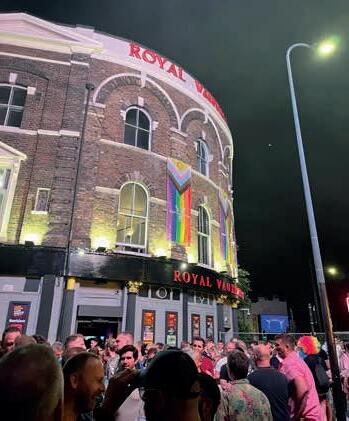
This work explores the concept of ‘queering the city’, recognising the heteronormative forces that shape our cities and countering them to create inclusive and safe spaces for all.
Vrushi Pravinkumar Patel
Urban Karigar: Reviving Indian Treasures
This dissertation focuses on the Urban Karigar communities (Kumbhar Wada, Mumbai). It considers the issues they are faced with and what could be done to help them grow sustainably. The study aims to determine how community and art can promote social and economic cohesiveness in the public realm and be beneficial to a society and its cultural heritage.
Natasha Razib From Theory to Practice: Improving communal spaces in Malaysian social housing
The paper examines communal space in low-cost housing in Malaysia from a design perspective, highlighting its significance in low-cost housing developments. It aims to bridge theory and practice by offering design suggestions for the communal areas of the social flats, serving as a guideline for future retrofitting.

Büşra Sönmez Investigating the design conditions and testing the applicability of Barcelona’s superblocks
Neha Patil Cities for People: Public spaces as a device for Urban renewal
Examining Mumbai's urban rise and fall, this thesis investigates factors behind its decline and the public realm's role in renewal. It aims to create a toolkit for urban renewal through the public realm in developing nations such as India.
Dipu Kishorbhai Sherathiya Investigating the relationship between urban design qualities & residential property value

The research aims to investigate the relationship between urban design qualities and residential property value to determine if and how it influences property value. It analyses multiple design characteristics, such as exterior aesthetics and enclosure, to assess their contribution to property value.
Growing from an interest in Barcelona's Superblock strategy, this study investigates the morphological and spatial conditions of this urban design intervention and test their applicability to London.. The study analyses the sustainable development and mobility concepts behind this urban design philosophy including its effects on traffic calming, creating walkable neighbourhoods, and the wider ramifications for the city.
MA Urban Design | Masters
Tony Lloyd-Jones (Course Leader), Krystallia Kamvasinou (Dissertation Module Leader)
Giulio Verdini, Roudaina Al Khani, Andrew Boughton, Jim Coleman, Bill Erickson, Jeff Howard, Ripin Kalra, Sebastian Loew, David Mathewson, Johannes Novy, Federico Redin, David Seex, Abubokkar Siddiki, Ian Simpson, John Somers, Mireille Tchapi
Tony Lloyd-Jones is an architect, urban designer and planner involved in international development research and practice. He is Reader in International Planning and Sustainable Development and Director of Research and Consultancy at the Max Lock Centre.
Giulio Verdini is Reader in Urban Planning at the School of Architecture + Cities, and Visiting Professor at Mohammed VI Polytechnic University, Morocco. His research explores cultural sustainability and socially innovative territorial development in the context of fast urbanising countries.
Krystallia Kamvasinou is a senior lecturer, an architect and a landscape architect. Her research on the topic of Interim Spaces and Creative Use has been published widely in academic journals and books.
MA International Planning and Sustainable Development
Students: Hajira Anjum, Elaheh Behrouzinia, Maryam Khurram, Rukmini Gotmare, Ana Lopes Santos, Namrata Menon, Dorisa Mirzai, Dylan Rodrigues, Sumitra Simkhada, Fathima Sumayya, Thi To
THIS COURSE EXPLORES contemporary theories, policy and practice in planning and urban design for sustainable, inclusive and resilient development in cities, regions and communities in a rapidly urbanising world. It spans both developed and developing world contexts, in locations facing a wide range of growing climate change and other environmental, economic and social pressures and risks.
Structured around written assignments and studiobased projects undertaken in group workshops, which are supported by lectures, seminars, tutorials and site visits, the course is grounded in three core modules: Planning in a Globalising World; International Spatial Planning Practice; and Sustainable Neighbourhood Development. Students can then choose to follow one of two pathways: Spatial Planning has a strong urban design component and an emphasis on development planning; alternatively, the Urban Resilience pathway provides a sustainable development-focused route with a core emphasis on climate change risks, adaptation planning and natural hazard risk management.
The course is aligned with the UN’s Sustainable Development Goals and New Urban Agenda and we are a Habitat Partner University. The curriculum draws on the hands-on experience of the Max Lock Centre, an international development unit that has been actively involved in action- and policy-focused research across the developing world since 1995.
MAIPSD is aimed at international, UK and EU students with a relevant background who wish to gain an in-depth understanding of planning and sustainable development, whether to improve career prospects in their country or enter UK or international practice. The course is fully accredited by the Royal Town Planning Institute (RTPI) as a ‘combined planning programme’. Graduates from this course find employment as planners and urban designers, urban regeneration or environmental management specialists in private consultancy, local and national government, and non-governmental sectors in their own country or internationally, including international development agencies and financial institutions.
Guest Critics:
Darshana Chauhan (CoPlug ), Martyn Clark (Tripleline) , Nandini Dasgupta, Yann Leclerc (Dar Group) , Geoff Payne (Geoffrey Payne Associates) , Robert Sadlier
Special Thanks:
Camillo Boano (DPU) , Angelique Chettiparamb (University of Reading) , Malcolm Moor, Michael Mutter, Marion Roberts, Olivier Sykes (University of Liverpool) , Pat Wakely (DPU Associates) , Ya Ping Wang (University of Glasgow)
30
Masters | MA International Planning and Sustainable Development MAIPSD + MAUD students visiting socialist council estates in Ljubljiana

MA International Planning and Sustainable Development | Masters
MA International Planning and Sustainable Development selected theses 2023
Hajira Anjum
Car Dependency: How can its influence on urban planning be reduced?
This dissertation explores the intricate relationship between car dependency and urban planning, investigating how the overreliance on automobiles impacts city development, transportation infrastructure, environmental sustainability and social wellbeing. It considers potential solutions for fostering more sustainable and liveable urban environments.
Sumrita Simkhada
Exploring Social Inclusion in the Public Open Spaces of Kathmandu Valley: A case of Lainchaur and Tundikhel
vesThis research considers the multifaceted aspects of social inclusion shaped by Public Open Space in Kathmandu Valley through two case studies. The research uses different research methods to provide a comprehensive assessment of the current state and potential for the Kathmandu Valley, and offers recommendations for promoting conservation and inclusivity of public spaces in city planning.
Rukmini Gotmare
ment
Rukmini Gotmare
Feminist Perspectives in Urban Planning: Advancing gender equality and sustainable development
MA International Planning & Sustainable Development Faculty of Architecture and the Built Environment
This dissertation investigates feminist urban planning, an evolving paradigm that reimagines cities. It considers if and how this approach to community creation can overcome the marginalisation and exclusion of minority groups, challenging historic urban planning patterns which overlooked underprivileged communities.
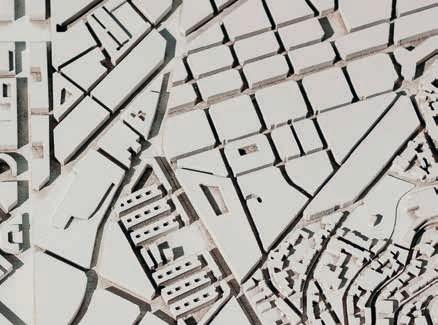
Maryam Khurram
Enhancing Neighbourhood Safety: Investigating the role of urban form in crime prevention and residents’ perception of safety
This research investigates various features in urban form and examines their impact on crime rates. The primary objective is to provide evidence about how factors such as street layout, land usage, building typology and density can deter or encourage antisocial behaviour in a neighbourhood. The study analyses two contrasting case studies in London: Kings Cross redevelopment and Aylesbury Estate in Walworth.

Namrata Menon
Integrating Parklets into London’s Urban Streetscape: Challenges and opportunities

Examining the potential of parklets in London, this dissertation investigates the obstacles and advantages they offer to urban environments and communities. Furthermore, it analyses their implementation challenges and opportunities for enhancing public spaces.
enhancing the influence of underrepresented groups ningful participation in decision-making processes. This
32
Masters | MA International Planning and Sustainable Development
h i d i d bj i i h i i
Fathima Sumayya Diminishing Public Open Spaces in Greater Mumbai: An analysis
This study explores the challenges of urbanisation in Mumbai, focusing on its impact on public open spaces and sustainability. It examines the current state, causes of deterioration, laws and regulations, and community perceptions, emphasising how past development plans as well as the Revised Draft Development Plan 2014-34 consider preserving public open space in the city.

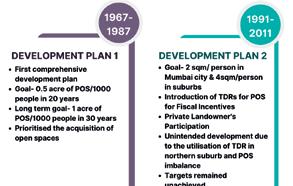
Dylan Rodrigues
Old Meets New: A comparative assessment of sustainability in transport management between London underground and Singapore’s MRT
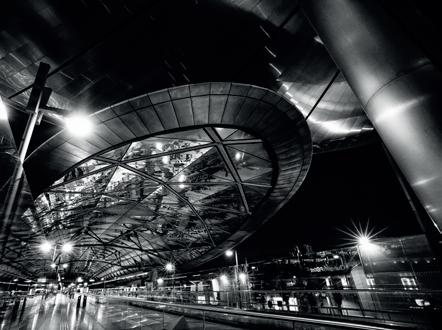


Comparing London's Underground with Singapore's MRT, this study delves into their historic evolution, as well as their social, economic, and environmental sustainability strategies. Reflecting on the interplay with urban planning, it offers insights into sustainable transport and city planning.
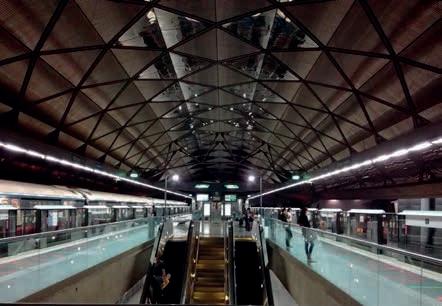

Thi To Urban Planning Solutions towards Sustainable Transport in Hanoi as a Future Megacity
The dissertation explores the nature of key urban transport issues and the relationship between transport and urban structure. Through the primary case study of Hanoi, it considers sustainable transport solutions through planning while reflecting on the wider implications they can have on the city.

MA International Planning and Sustainable Development | Masters
(top to bottom) London tube platform [photo Glen Scott] ; London tube tunnel [photo by author] ; Expo MRT station, Singapore [photo Mac Qin]
Rutendo Musikavanhu (course leader), Dimah Ajeeb, Ian Arnott, Stroma Cole, Helen Farrell, Anne Graham, Lindsey Hanford, Clare Inkson, Josef Jammerbund, Maja Jović, Fatemeh
Mohamadi, Chiara Orefice, Ilaria Pappalepore, Andrew Smith
Rutendo Musikavanhu is an experienced academic, skilled in education, strategic leadership, mega-sport events, tourism and hospitality. She is a strong research professional with interests in the legacy and social impacts of mega events.
MA Event Design & Management MA Tourism Management
MAEDM Students: Anjali Anjali, Saikiran Reddy Aenugu, Ahmed Almubarak, Sarah Alrabeh, Ella Marie Aunaas, Rebecca Cummins, Arslane Dilane Rahmoune, Joe Divall, Gayatriben Dixitkumar Patel, Sara Ghiglione, Salome Gracio, Jolly Ikekhide, Julia Immordino, Sourav Kanodia, Parul, Arsha Koyyodan Puthiyapurayil, Federica Latronico, Ifeoluwa Makinde, Maya Mira, Anna Nalesnik, Mary Neophytou, Priya Patel, Marina Pérez Silvestre,
THE MA COURSES in Event Design and Management and Tourism Management are strongly aligned and delivered by a close-knit team who combine established academics, early career researchers and a range of professional experience in events and tourism.
Our sister courses hold a unique position within the UK higher education sector due to their situation within an architectural school. We take a distinctive position on the spaces and places for tourism and events with a focus on destinations and the urban environment, drawing on our own research and links with industry in London and further afield.
A growing area of specialism is the field of experience design and our MA course was successfully relaunched in September 2018 (with increased enrolments) to focus further on the creative design aspects of event management.
We attract a diverse and highly international community of students who come to the courses with a range of education and prior experience. All of this makes for a
Ruxandra Petrescu, Tegan Rees, Chiara-Vivien Reichert, Victoria Rezajew, Jenine Sandhu, Serena Smith, Shilpa Sooda, Agata Wapner
MATM Students: Simona Andruskova, Lia Ciancimino, Nikhil Dhimmar, Sanika Kulkarni, Syed Hasan Munir, Heena Ashok Parmar, Muhammad Rakha Ramadhan, Sohel Shaikh, Selin Yilmaz, Xinzhi Zhou
dynamic and rich study environment for students and staff alike, and well reflects the global nature of professional work in tourism and events.
These taught masters courses provide students with the opportunity to focus their studies through a range of optional modules. These reflect the research interests of the staff team including creative experience design, global festivals and events, the inter-relationships between tourism, culture and society, airport and airline management and tourism entrepreneurship. We are fortunate to draw on excellent industry links to provide a range of guest speakers, visiting lecturers and field trips.
The courses combine small-group classes, some studio work, experiential learning and independent study. In the final phase of their studies students produce a thesis using original primary research.
Our alumni have been recognised for their scholarly and professional achievements, including multiple winners of the Tourism Management Institute’s Postgraduate Dissertation Prize.
34 Masters | MA Event Design & Management
MA Event Design and Management
Theses 2023
Saikiran Reddy Aenugu
Informed practices to improve green practices for event managers: A case study of the UK hospitality industry
Ahmed Almubarak
Mega Sport Event Sponsorship: Strategy for developing market brand value for global brands
Sarah Alrabeh
A Critical Approach to the Effects of City Branding: The Medusa Music Festival case
Anjali Anjali
Events as a strategic tool
Ella Marie Aunaas
“The Most Beautiful Show in the World Right Now”: Karpe's 10 x Oslo Spektrum (A case study)
Rebecca Cummins
An exploration of the role immersive experiences play in aiding brand engagement
Arslane Dilane Rahmoune
The business of middle east tourists for hosting destinations: Comparison of Turkey, Malaysia and Indonesia
Joe Divall
Juxtaposition of modernity and tradition: How do you modernise the FA Cup, football's oldest Final?
Gayatriben Dixitkumar Patel
Enhancing event design in tourism management
Sara Ghiglione
Examination of how the Salone Nautico boat show has improved tourism and facilities in Genova
Salome Gracio
The impact of streaming services on the attendance of live music events by millennials
Jolly Ikekhide
Project management strategies in achieving sustainable event venue in developing region
Julia Immordino
What does the future generation of event planning entrepreneurs in the US look like?
Sourav Kanodia
Destination weddings in India: An analysis of the factors driving its growth and its implications on the event management industry
Arsha Koyyodan Puthiyapurayil
Examinination of the efficacy of UK's eco-tourism initiatives on local biodiversity conservation and community empowerment
Federica Latronico
The case of Morando Pet Food, Italy: Examination of field marketing strategies in company event portfolio
Ifeoluwa Makinde
Lagos Fashion Week Awareness and Brand Sponsorship: A case study of Tecno Mobile
Maya Mira
Effects of climate change and environmental sustainability on preference for architecture
Anna Nalesnik
Korean Wave: The role of music festivals in South Korea’s destination portfolio development
Mary Neophytou
The impact of local festivals in the framework of developing sustainable tourism in Cyprus
Parul
Leveraging gamification in events to boost brand-loyalty of sports brands
Priya Patel
Technologies for event design tourism management
Marina Pérez Silvestre
What is the future of gastronomic events? Research and proposal for immersive dining experiences
Ruxandra Petrescu
Examination of local London arts' venues and the post-pandemic consequences
Tegan Rees
The influence of social media on how UK wedding vendors market their businesses within the industry
Chiara-Vivien Reichert
Formula 1 and Digital Marketing: Effectiveness of brand awareness through TikTok phenomenon
Victoria Rezajew
Examining brand engagement from motorsport events sponsorships: A Consumer Perspective
Jenine Sandhu
How sustainable supply chains are developing in Delhi and are engaging with the event industry in the city
Serena Smith
An exploration of how millennials & wedding planners manage cultural identities and diaspora when planning a wedding
Shilpa Sooda
Rise of Influencer-based events in Indian B2C marketing and their future
Agata Wapner
Events as a tool to promote Korean culture in London
MA Tourism Management
Theses 2023
Simona Andruskova
Generation Z’s climate friendly travel behaviour: Rhetoric vs reality
Lia Ciancimino
New York Christmas Appeal: Factors that make a destination seasonally desirable to tourists
Nikhil Dhimmar
Sustainable Tourism Development of Gujarat
Sanika Kulkarni
‘Zindagi Na Milegi Dobara’: How movies influence Indian experiential tourism in Spain
Syed Hasan Munir
Tourism in Peshawar: The effect of social media influencers
Heena Ashok Parmar
Destination Management Organisation: Educating travel agents about responsible tourism
Muhammad Rakha Ramadhan
Destination Branding Lombok as Indonesia’s Five Super Priority Destinations for Indonesia Market
Sohel Shaikh
Tourist Behaviour and Motivation: An investigation of personal and local influencing factors
Selin Yilmaz
Sports Tourism: The benefits to Turkey of hosting the football World Cup tournament
Xinzhi Zhou
Research on the Development and Evolution of Cultural Tourism in Qufu, China
MA Tourism Management | Masters
Nigel Dennis (Course Leader), Andrew Cook, Frances Kremarik
Nigel Dennis is the course leader and a specialist in airline economics, forecasting, scheduling and marketing. He has served on international committees including those of the Transportation Research Board in the US and the Association for European Transport.
Andrew Cook leads the department’s air traffic management research and sits on national and international ATM committees. He also lectures on air transport market research and data analysis.
Frances Kremarik assists with the day-to-day running of the course and specialises in airline networks and the North Atlantic market as well as air travel statistics and surveys.
MSc Air Transport Planning and Management
THE MSC AIR Transport Planning and Management is a very practical course that brings together academic content with a large number of specialist contributors from the aviation industry. It is uniquely taught in block mode where students attend for modules of five days’ duration, making it very accessible to part-time students working in the aviation industry both in the UK and internationally. Additional activities are arranged for fulltime students in-between the module blocks, including tutorial and discussion sessions, guest lectures and visits to airport facilities and outside events.
Students come from a range of disciplines (first degrees have included Economics, Geography, Engineering, Languages and Music). No prior knowledge of the air transport industry is assumed but a passion for aviation is one of the best qualifications taken in conjunction with a formal academic background or equivalent appropriate work experience.
Students take three taught core modules: Air Transport Economics; Air Transport Management and Operations; Air Transport Forecasting and Market Research; and three taught option modules, currently from a choice of
four: Airport Finance and Strategy; Air Transport Policy and Planning; Airline Marketing and Business Models; and Air Traffic Management, Scheduling and Network Planning. Students also have the possibility of a free choice module from another suitable programme in place of one of the three options. Most modules include a group workshop or business game in which students apply their knowledge to work as a team in a competitive environment.
The Research Dissertation is also a core module undertaken in the second half of the study period. A wide range of aspects of the aviation business can be analysed and this year’s dissertations have covered subjects including: reducing airline mishandled baggage; an analysis of the role weather plays in commercial air accidents; the future of small UK regional airports following the pandemic; improving efficiency in flight dispatch; investigating the cost impacts of on-time performance; alternative heating and lighting solutions for airports; analysis of the technical feasibility and suitable markets for electric or hydrogen powered regional aircraft; and the potential for a new supersonic aircraft.
Guest Speakers:
Carole Blackshaw (aviation consultant) , Robert Boyle (formerly IAG) ,
Guillaume Burghouwt (Schiphol Group) , Adrian Clark (NATS) , Nick Fadugba (African Aviation Services Ltd) , Tim Hawkins (Manchester Airports Group) ,
Stuart Holder (Civil Aviation Authority) , Kelly Ison (American Airlines) ,
Antoinette Nassopoulos (Foster and Partners) ,
Tim Wheen (Heathrow Airport)
36 Masters | MSc Air Transport Planning and Management
Marzena Piotrowska (Course Leader), Julian Allen, Mengqiu (Matthew) Cao, Jacques Leonardi, Maja Piecyk, Allan Woodburn
Marzena Piotrowska is Research Fellow and lecturer whose primary research interests focus on city logistics, urban freight consolidation and transport policy. Her current research centres on the role of urban freight consolidation facilities in supporting sustainable city logistics.
Julian Allen is Senior Research Fellow. His research interests include the role of transport policy in reducing the negative impacts of logistics operations, developments in retailing and their relationship with logistics and transportation systems, and the history of freight transport.
Mengqiu (Matthew) Cao is Senior Lecturer in Transport and Urban Planning at the School of Architecture and Cities. He has worked in both academia and industry, specialising in an interdisciplinary research field crossing transport analysis and urban studies.
Jacques Leonardi is Professor of Sustainable Logistics with over 20 years’ experience in developing, testing and evaluating sustainable logistics solutions. His research focuses on supply chain energy and global logistics, and applies methods to evaluate new technologies and policy impacts.
Maja Piecyk is Professor in Logistics. Her research interests focus on the optimisation of supply chain networks, GHG auditing of businesses and the sustainability of freight transport operations. Piecyk is a Chartered Member of the Chartered Institute of Logistics and Transport (UK).
Allan Woodburn is Principal Lecturer in Freight Transport and Logistics, with over 25 years’ teaching experience. He often works on industry research and consultancy and his research focuses on different aspects of rail freight including policy, operations, sustainability and efficiency.
MSc Logistics and Supply Chain Management
MSC LOGISTICS AND SUPPLY CHAIN MANAGEMENT, introduced in 1998, is one of the longest established logistics postgraduate courses in the United Kingdom. The course has been designed to combine logistics concepts and principles with ‘real world’ experience, with a particular emphasis on issues relating to freight transport (i.e. product flow) within the supply chain. The course delivery encourages reflective and critical thinking in helping students to extend existing skills and competencies. In particular, students are given guidance on developing their skills for undertaking personal research, and a considerable amount of time is spent by the student on personal study for the Research Dissertation.
The course can be taken full-time over 12 months or parttime over 2 years, starting in September. We also offer a Logistics and Supply Chain Management Postgraduate Diploma and a Logistics and Supply Chain Management Postgraduate Certificate. The Diploma usually takes one year to complete full-time, while the Certificate usually takes six months to one year to complete part-time. Each
taught module occupies a three-hour slot per week. Modules use a variety of teaching and learning methods including academic lectures, seminars, tutorials, case studies, guest speakers, site visits, small group exercises, and group and individual presentations.
The course attracts a diverse, international group of students which is of particular benefit to a programme that focuses strongly on international logistics and supply chains. Over the years, students on the course have come from all parts of the world and have brought a huge variety of educational and professional experience.
The course team is highly active in freight-related research and consultancy projects, with a particular focus on freight transport efficiency and sustainability. The curriculum is updated regularly based upon our research which ensures that the course content and overall strategy reflect current issues in logistics practice, preparing students for careers in this area. We work closely with clients and project partners in both the private and public sectors.
MSc Logistics and Supply Chain Management | Masters
Enrica Papa, Rachel Aldred, Mengqiu (Matthew) Cao, Tom Cohen, Luz Navarro Eslava, Ersilia Verlinghieri
Enrica Papa is Reader in Transport Planning and course leader of the MSc. Her main research interest is in sustainable accessibility planning.
Rachel Aldred is Professor in Transport and Director of the Active Travel Academy.
Mengqiu (Matthew) Cao is Senior Lecturer in Transport, Logistics and Urban Planning at the University of Westminster.
Tom Cohen is Reader in Transport at Westminster and a member of the Active Travel Academy. His research interest is in transport policy.
Luz Navarro Eslava is Lecturer in Planning at the University of Westminster and a member of the Active Travel Academy
Ersilia Verlinghieri is a Senior Research Associate in Urban Mobility at Westminster and a member of the Active Travel Academy
MSc Transport Planning and Management
THE MSC TRANSPORT PLANNING and Management course aims to develop the students’ abilities to initiate and undertake qualitative and quantitative analysis and research in the areas of transport policy, planning and operational management.
The course intake is diverse in terms of background and sector experience. Students without experience in the sector are enabled to equip themselves with knowledge, techniques and methodologies required to take policy decisions or to provide the necessary information/ knowledge for others to take such decisions. They benefit from learning from the experiences and knowledge of part-time professional students, who in turn benefit from the opportunity to critically reflect on their own practice and examine transport, policy and planning issues from a wider perspective than their present employment.
The overall objectives are to provide all students with a stimulating academic environment within which to study transport issues, to ensure students are aware of current transport policy and planning issues and to prepare them for a wide range of potential employment within
the transport sector by developing relevant transferable skills. The course is accredited by the Chartered Institute of Logistics and Transport (CILT), and graduates are exempt from the Institute’s exams. The Course also forms part of the pathway to the Transport Planning Professional (TPP) qualification.
Students following this course develop a critical, in-depth understanding of key transport issues, alongside the skills that will help them progress careers within the sector. The course team is in regular contact with key employers, many of whom both sponsor current employees and employ our recent graduates. Such employers frequently provide information about vacancies and come into the University to speak about the opportunities that they offer. Some offer to partner with full-time students on key dissertation topics of interest, for example providing data for analysis, which can be an excellent route into the industry.
Many of our graduate have progressed to senior levels in management and policy-making within transport operators, public bodies, consultancy companies and non-governmental organisations.
38 Masters | MSc Transport Planning and Management
Special thanks: Michael Barratt (TfL) , David Carrignon (Arcadis) , Adrian Hames (WSP)
MSc Transport Planning and Management Theses 2023
David Asiedu Ayim
Public bus transport and road crashes in Ghana
Samuel Goddard
Are patterns observed in London’s Low Traffic Neighbourhoods being replicated in Local Authorities outside of London?
William Hummerstone
The ‘Share Mile’: Investigating the potential for ‘shared space’ in the streets of the City of London
Yunfei Liu Liu
The impact of high cost HSR on the choice of transportation modes for Chinese travellers
Olayinka Omotosho
Transport infrastructure provisions and its effects on primary school children in Ondo city, south-western Nigeria
Christine Ssebowa-Ascott
An evaluation of e-scooters as an alternative, environmentally friendly mode of transport
Olakunle Faleti
An evaluation of construction logistics planning and the role of vehicle holding areas in London
Hashan Maduwa Guruge
How to affect the post-Covid-19 transport behaviours of London commuters
Sonia Kazemi
Study into the feasibility of implementing intelligent transport systems to organise the mobility systems within urban historical textures
Lucy Molloy
Is ‘predict and provide’ outdated in the world of transport planning? Exploring new transport planning approaches in the context of rural counties: A case study of Buckinghamshire
Nicolas Schonwald-Bavaro
To what degree can the development of the transport network in Delta county, Colorado USA, be inspired by the successful rural transportation network in the Rhinetal Valley, Switzerland?
Emily Flinchum
Determining how and where 15-minute cities can best be adapted and implemented in urban centres in the United States
Justin Hooley
An assessment of whether e-scooters should be integrated into the existing UK transport study of Buckinghamshire Council’s e-scooter trials
Andre Klebl
The ‘Netflix of Bikes’: How can bicycle subscription models contribute to more active travel in European cities?
Joshua O’Donnell
Are the Elizabeth line and the London bus network opportunities for urban growth, and what does this mean for existing bus routes?
Merylyn Webb
The effect of public transport quality on car usage in London
MSc Transport Planning and Management | Masters
Johannes Novy (Course Leader), Andrew Boughton, Suzy Nelson, David Seex, Ian Simpson, John Somers, Nancy Stevenson (dissertation tutors)
Johannes Novy is a Senior Lecturer in Urban Planning and holds a PhD in Urban Planning from Columbia University, New York. In addition to his work in teaching and research, he is a founding member of the Berlin collective u-Lab, Studio für Stadt und Raumprozesse, and a member of the Curatorial Board of the International Building Exhibition Stuttgart Region IBA2027.
MA Urban and Regional Planning
ENGAGED IN AN INTENSE learning experience, students of the MA Urban and Regional Planning course can study full- or part-time, and includes those who are new to planning but with a background in a related area, as well as others who are already working in London or further afield. The course culminates in the final thesis which students use as a vehicle to explore a wide range of exciting topics, mirroring the concerns and interests of planning practitioners and researchers today.
While for many years urban planning was perceived as a discipline in crisis whose meaning, purpose and practice were questioned by many, this is no longer the case in today's crisis-ridden times. The increasingly evident effects of climate change and the general fragility that characterises today's world, was central to many of our discussions. The prevailing view was that the challenges we and the world at large face, while daunting, also present opportunities for planning and, crucially, that planning as a profession has a big role to play in addressing them.
With regard to tackling the climate crisis, it is now widely recognised that urban planning has an essential role to play. Place matters: the quality of our built environment has a direct impact on our wellbeing, both as individuals
and as a community, and planning can help ensure that the places we inhabit benefit rather than harm us.
Given the importance of planning for individuals, communities and societies at large, the discipline also has a great (ethical) responsibility which is something we regularly draw students' attention to. We also communicate to students that they should use their time with us and the work they put into their studies, and especially their dissertation, wisely. Notable topics this year included the future of High Streets as important commercial and social hubs, the ongoing – and heated – debate about the need to reform England's planning system, the potential and limitations of digital technology for democratising planning, and the promise of Green and Blue Infrastructure for improving health and wellbeing.
Many of the dissertations not only showcase the talent of our students, but also their commitment to the core mission of planning: enhancing the built environment to improve people's lives. Their work serves as a reminder of the enduring importance of our field in shaping sustainable, equitable and vibrant communities. Looking ahead, I am excited about the contributions our students will make as they continue their journeys in the planning profession.
40 Masters | MA Urban and Regional Planning
Students: Kaya Allnutt, Fatimat Bakare, Helen Bonham, Katherine Elworthy, Lucy Fawcett, Avigayil Fishburn, Isha Ashutosh Hasme, Christopher Lamb,
Taelin-Jordan Lambert, Grace Logan, Harvey Moodley, Brooke Pride, Rebecca Tilley
MA Urban and Regional Planning Theses 2023
Kaya Allnutt
A Critical Evaluation of Status and Protection beyond the National Heritage List for England (NHLE): How do we secure the protection of NonDesignated Heritage Assets?
Fatimat Bakare
How Democratic and Representative are Local Planning Consultations?
Helen Bonham
Community Engagement: Planning as a collaborative community-led process
Katherine Elworthy
Righteous Control: Moral appeals in the contemporary English planning liberalisation debate
Lucy Fawcett
The Decline of the High Street: A study of two Islington high streets and their varying degrees of prosperity following the COVID-19 pandemic
Avigayil Fishburn
Are Car-free Developments in London Selfselective? An investigation, and study of whether they discriminate against people with disabilities
Isha Ashutosh Hasme
Urban Form of a Neighbourhood and its Correlation with Energy Usage
Christopher Lamb
Deregulation vs Design: Situating the role and impact of permitted development within the UK government’s Levelling Up planning agenda
Taelin-Jordan Lambert
High Speed Rail and its Potential for Urban Regeneration: Leeds case study
Grace Logan
Investigating the impacts of Green and Blue infrastructure development on health and wellbeing in the Metropolitan Borough of Battersea
Harvey Moodley
An investigation into the impact of small site housing contributions towards affordable housing delivery in Surrey
Brooke Pride
Is there a Third Way to Developing within the Metropolitan Green Belt?
Rebecca Tilley
Planning for Education: A critical analysis of design review panels in England to inform a framework for design reviews for schools
MA Urban and Regional Planning | Masters
PROFESSIONAL STUDIES FORMS an integral component of all courses across the School of Architecture + Cities at both postgraduate and undergraduate levels. Our role is to help students develop ways of working together and build an understanding of their role in the complex landscape of practice, whatever their subject focus.
The nature of working and practicing within fields of urban design, planning and strategy means that students are expected to contribute to society in a variety of ways when they move into the workplace. Professional studies is an opportunity to develop working practices with colleagues, in addition to cultivating an appreciation of personal, economic and intellectual well-being.
Professional practice and ethics is drawn out of the courses in a variety of ways from design to
contextual studies. For example, undergraduate architecture students take a two-week work experience placement at participating design practices; having been developed at BA level, a live design studio is now included in the Master of Architecture [Part 2] programme and will be the basis for developing a live design practice within the school; while the PG Diploma Professional Practice in Architecture [Part 3] is the largest such course in the UK. Supported by staff and professionallypracticing teaching fellows, the symbiosis between teaching and practice is further cemented at this important stage of professional development for architects by recent course graduates becoming Part 3 Champions and mentoring current postgraduate and undergraduate students.
Alastair Blyth Assistant Head, School of Architecture + Cities
PRACTICE & STUDY
RIBA Part 3
Alastair Blyth, Wilfred Achille, Susanne Bauer & Stephen Brookhouse
THE SCHOOL OF ARCHITECTURE + CITIES runs the largest RIBA Part 3 programme in the UK. This year (2022-23) over 470 students enrolled on the course. The students come from a wide variety of backgrounds including overseas schools of architecture. Architects who trained outside the UK also attend the course to gain an in-depth understanding of the complexities of UK practice.
Following the requirements of the ARB/RIBA Professional Criteria, Part 3 is structured as a series of building blocks with clear assessment points throughout the year. The lectures, delivered by industry experts, allow students to balance attendance with work commitments and are recorded for easy future access.
Students’ professional development in the workplace is supported by a team of 40 professional tutors – all architects in practice – who provide one-to-one tutorial
guidance on project-based coursework. Professional examiners consistently comment on the high, critical standard of the coursework which we attribute to the structured tutoring system where students are challenged to think about practice differently.
The students' personal backgrounds, the types and number of practices represented on the course, along with the tutors and examiners gives the course an unprecedented reach into the architectural profession. This enables the course both to draw from the breadth of practice experience as well as contribute to it.
The Part 3 Course was validated by the RIBA for a further five years in November 2022. The Visiting Board gave it Commendation, citing the efforts of ‘Part 3 staff (both full-time and part-time) in producing an outstanding programme that is integrated and holistic, in preparation for architectural practice’.
Wilfred Achille
Wilfred Achille is Co-Course Leader. Wilfred completed a major study on Broadwater Farm, Tottenham after the eighties riots. Founder of Mode 1 Architects specialising in estate remodelling projects and urban regeneration, he is developing new Turn-key solution business models for architectural practice.
Alastair Blyth is Assistant Head of School and Co-Course Leader. He spent ten years in the Directorate for Education and Skills at the OECD developing a research programme on learning environments. Publications include books on Briefing (Routledge, 2001, 2010); and education environments (OECD 2009, 2012). He collaborates with architectural practices in Sydney and Mexico on school building projects, and is part of an international project investigating Innovative Learning Environments and Student Engagement run by the University of Melbourne.
Susanne Bauer is Senior Lecturer in the Professional Practice in Architecture and the Architectural History and Theory courses. She has practiced in offices in the UK and Germany, including Foster + Partners and AHMM, and previously taught at Norwich University of the Arts and Birmingham City University.
Stephen Brookhouse is Professor Emeritus and contributes to the Part 3 course. He is a chartered architect with over 20 years' experience in practice has authored the first three editions of the Part 3 Handbook as well as Professional Studies in Architecture: A Primer
44 Practice & Study | RIBA Part 3
Alastair Blyth
Lecture-based Modules

The two lecture-based modules are delivered during the first semester. The lecture programmes are delivered by differing industry experts, including construction lawyers, construction managers, architects and surveyors, and are
repeated to allow students to balance attendance with work commitments. Lectures are video recorded for easy future access. Each series concludes with an open book written exam.












Architectural Practice Management









This module is delivered as an intensive short course in January with a written examination held in May. The 12 lectures cover general management, marketing and practice management, as well as managing health and safety, different forms of architectural practice and the role of the professional and regulatory bodies.
English Law, Regulations, Construction Procurement and Contracts

This module is delivered as a programme of evening lectures from September to December with a written examination held in January. The module starts with an overview of the English legal system, the regulatory framework that architectural practitioners work with, the procurement of construction projects, the range of contracts used in practice and dispute resolution. Throughout the course students are encouraged to place the issues covered in the context of their practice as well as other experience they will have had.

RIBA Part 3 | Practice & Studies
Lecture-based module Padlet records
RIBA Part 3





Work-based Modules







These are supported by a team of 44 professional tutors – most of whom are architects in practice – who provide one-to-one tutorial guidance and act as the students’ professional studies advisors for the year. Tutors arrange a mix of group and individual tutorials and additionally provide individual advice by email where needed.
The Professional Case Study


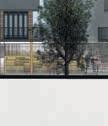
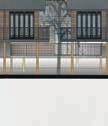









The aim of the module is to bring together student’s knowledge of practice including management, legal frameworks, procurement and critical analysis in the context of a construction project, drawing substantially on their own experience. It aims to build on the theory studied in the lecture-based modules, and provide an opportunity to make professional judgements. The case study covers the practice, the design team, appointment, regulatory framework, procurement, and the construction stage. Students are asked
The work-based modules are also supported by a lecture programme. Students may defer submission of the coursework for the work-based modules for either six or twelve months to enable them to respond to their workplace context.
to analyse their project against best practice, and make recommendations for future practice based on their analysis.
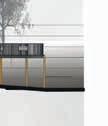





Students submit a draft case study in March and receive formative assessment and feedback in April. The final coursework is submitted in June and assessed in July. Guidance is given on preparing for the oral examination which takes place in September.

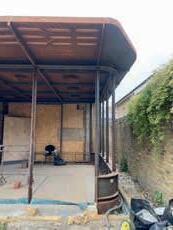


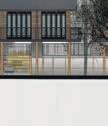

46
Practice & Study | RIBA Part 3
Prefabricated Gallery Segment, Craned into Place Prefabricated Gallery Segment, Craned into Place Gallery Structure Corten Steel EDWARD WILLIAMS ARCHITECTS Wandsworth, London Prefabricated Gallery Segment, Craned into Place Prefabricated Gallery Segment, Craned into Place Gallery Structure Corten Steel EDWARD WILLIAMS ARCHITECTS Wandsworth, London Prefabricated Gallery Segment, Craned into Place Prefabricated Gallery Segment, Craned into Place Gallery Structure Corten Steel EDWARD WILLIAMS ARCHITECTS Wandsworth, London
(left) Clovis Kamaha: ‘Get Away resort for the Elderly with Dementia': Section & elevation; (right) Kavi Mitchell: Domestic extension, London [Edward Williams Architects];
RIBA Part 3
Work-based Modules contd









Professional Development and Experience

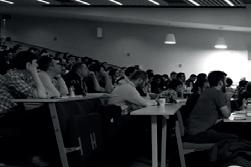
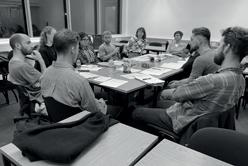
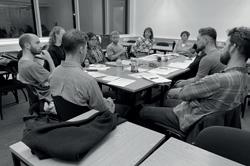

This work-based module tracks and supports the student’s professional development in the workplace. A student’s professional development is discussed with their Professional Tutor who provides guidance on the professional Curriculum Vitae and the Career Evaluation as well as guidance on preparing for the oral examination. Coursework, comprising the CV, Career Evaluation and PEDR sheets, is submitted in June and assessed in July. Students are required to complete PEDRs for the duration of the course and the PEDR sheets are reviewed on a quarterly basis.


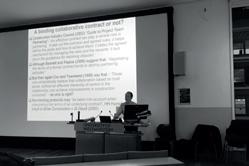
Oral Examinations

Oral examinations for both modules take place in early September, with interviews generally lasting 45 minutes. Professional Examiners are paired and will see six students over a day. Their role is to assess the candidate’s performance at oral only and the interviews are based on the Professional Case Study and the Professional Development coursework submitted. The written coursework will have been marked already and the examiners will see the feedback given to students.

RIBA Part 3 | Practice & Study
Students meeting to discuss professional development in the work place, and prepare for oral examinations
Live Design Practice
openstudiowestminster.org/beyond-studio/live-design-practice/
LIVE DESIGN PRACTICE is part of the new MArch Studio run by Maria Kramer. Through it, we introduce new ways of working collaboratively across sectors by taking our multidisciplinary skills within academia and using these in live projects to serve communities. It is a process that promotes an understanding of complex relationships between stakeholders while introducing novel ways of practice, making broader participation exciting, engaging and empowering.
Our approach is to use Live Projects as a way to understand issues and ask questions. This enables deep reflection on the interaction between spatial, political, economic and social factors in relation to our lived urban experience. This process of design is iterative and demonstrates applied and action research. Significantly, the tangible physical aspect of projects connects to and communicates with a wide audience of users.
Cody Dock
How can architecture be practiced responsibly in terms of creating new social and cultural relationships to our natural environment? This is the question MArch DS20 students responded to in the context of the post-industrial landscape around the abandoned former coke smelting wharf, Cody Dock. This complex site adjacent to the River Lea has become a thriving ecological base, but the fragile community is threatened: increasingly dwarfed by extensive high rise housing, and by a river with high levels of toxicity.
Through field work, site analysis, experimental model making and drawing, students explored how to create neighbourhoods to encourage social interactions and meaningful places while promoting ecological awareness and ‘civic-ness’, strengthening local identity and culture.
In parallel to the Live Studio, which we hope will leave a legacy of learning in the community, underlining the projects undertaken by Cody Dock, students developed ambitious investigative thesis proposals. The individual projects explored dynamic interactions between the existing conditions and future engagement with the area, forming a multi-programmatic masterplan with ecological regenerative principals at its heart.
The locus for this analysis was the unique opportunity to work with a diverse set of clients who informed the studio’s Live Project: the QHT-funded (university) Therapeutic Horticultural Hub at Cody Dock. The students were involved in context-based professional practice learning, gaining direct, experience and the opportunity to be involved in all work stages.
Maria Kramer Project Lead
Thanks to:
48 Practice & Study | Live Design
(top) : Design, build and use of the Horticultural Hub; (centre & bottom left) Will Lambert: ; (centre & bottom right)
Hamza Khan
Wilfred Achilles, Peter Bonfield, Harry Charrington, Tom Cohen, Nic Henninger, Will McLean, Chris Meloy, Simon Myers, Enrica Papa, Huan Rimington, Nick Runeckles, Ro Spankie, Ben Stringer, Steve Webb, Camilla Wilkinson, Julian Williams
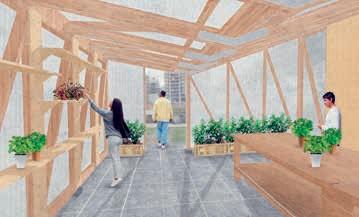












































































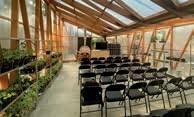
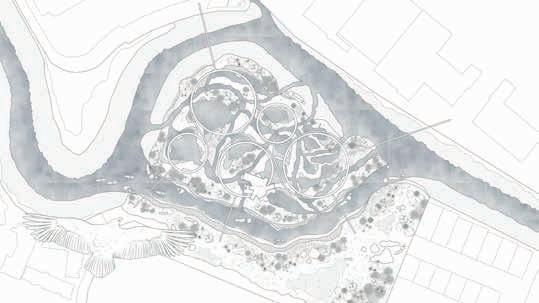

Live Design | Practice & Study
RESEARCH AND KNOWLEDGE Exchange in the School of Architecture + Cities is organised into five interdisciplinary research groups and four research centres. The research groups are: Architectural Humanities; Emerging Territories; Place and Experience; Making and Practice; and Transport and Mobilities. The groups comprise staff and PhD students working on common themes who organise their own symposia, exhibitions, mentoring sessions and other events. The research centres are: the Active Travel Academy; Air Transport Management Centre; the Max Lock Centre; and the Centre for the Production of the Built Environment (co-hosted by the Westminster Business School). Research centres include full time researchers working on funded projects.
One of the most important cycles in the UK university sector research calendar is the Research Excellence
Framework (REF) evaluations that take place every 6-7 years. In 2021, the School of Architecture + Cities submitted 77 members of staff, 159 research outputs and five impact case studies to the REF, and were rated 7th in the country for research power, a metric reflecting the number of people submitted and the overall quality of research. Our impact case studies were also assessed very highly. This reflects the excellent quality and quantity of research being undertaken in the school.
Since the last REF, higher education research is now coupled with knowledge exchange, which comprises research partnerships with business or community groups, short courses, and public and community engagement events. For further details about ongoing events and outputs by our research and knowledge exchange community visit:
http://www.openresearchwestminster.org/
Lindsay Bremner SA+C Director of Research
50
RESEARCH
RESEARCH GROUPS
Architectural Humanities

Members of the Architectural Humanities Research Group address critical questions about architecture and its historical, social and cultural contexts by engaging with a range of humanities-based methods, including interdisciplinary approaches that bring together arts and sciences.
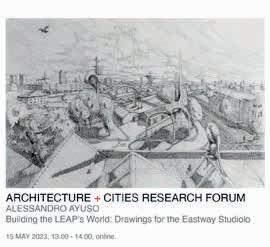

Convened by Kate Jordan and Davide Deriu
Place and Experience
The Place and Experience Research Group focuses on tourism, events and leisure research with specialisms in: City Tourism, Mega Events, Urban Parks, Destination Community Experiences, and Sustainability.

Convened by Stroma Cole and Ilaria Pappalepore
Emerging Territories

The Emerging Territories Research Group focuses on societal and environmental challenges faced by cities and territories in relation to evolving notions of sustainability and resilience, climate change, healthy cities, governance, diversity and social inclusion. Key themes intersecting our research are: Climate Urbanism; Health, Wellbeing and Cities; Urban-Rural Interfaces; Anthropocene Territories; and Public Space and Diversity.
Convened by Krystallia Kamvasinou and Giulio Verdini
Transport and Mobilities

The Transport and Mobilities Research Group covers a diverse range of aspects of transport and mobility, including: City Mobilities, Active Travel, Freight, Infrastructure Investment, Networks, Accessibility and Transport Equity.
Convened by Gerald Gurtner and Enrica Papa
Making and Practice
The Making and Practice Research Group brings together award-winning design practitioners and leading academics who conduct innovative research through the process of practice and making. Collectively, they have exceptional expertise in the fields of representation, fabrication, live projects, experimental building projects, and environmental design.
Convened by Paolo Zaide and John Zhang

52
Research | Groups
Selection of Posters for the Architecture + Cities Research Forum
RESEARCH CENTRES

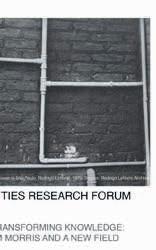
Active Travel Academy [ATA]
The ATA is an interdisciplinary research and knowledge exchange centre that currently leads projects funded by organisations including NIHR, DfT, and TfL. It hosts the Active Travel Studies journal and organises events including the regular Walking and Cycling@Teatime seminars. Director: Rachel Aldred
Max Lock Centre
The Max Lock Centre is an international development research unit drawing on planning and design expertise across the School of A+C and wider development-related expertise across the University. Focusing predominantly in the global South, for over 25 years it has investigated planning and design solutions for sustainable and inclusive development.
Directors: Tony Lloyd-Jones & Giulio Verdini
Centre for Air Traffic Management Research

CATMR builds on more than 20 years of research into air traffic management, for which the University of Westminster is well known. Working with academia, industry and international organisations, the group is active in projects funded by Clean Sky 2, SESAR and Horizon 2020.
Director: Andrew Cook; Co-Director: Luis Delgado
ProBE
ProBE provides a research hub, a forum for debate and discussion, and a focus for interdisciplinary and international activity related to the Production of the Built Environment as a social, environmental and historical process.
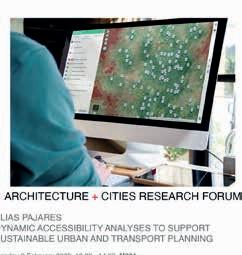
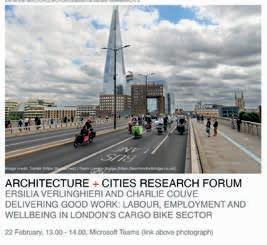


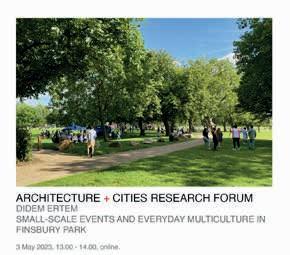
Director: Rosa Schiano-Phan

Centres | Research
Gender Ecologies
Corinna Dean
Funded by the British Council Pakistan/UK partnership (Gender Ecologies call) January – October 2023
THE GENDER ECOLOGIES PROJECT is a collaboration between architect Corinna Dean, architect Marvi Mazhar, filmmaker Zohaib Kazi and performance artist Abuzar Madhu.
Focusing on the Indus and Ravi Rivers in Pakistan, the project builds upon existing collaborations with farmers and community alleys fisherwomen and attempts to underscore the integral relationship between indigenous knowledge of land, ecology and cultural practices. As part of the project, a documentary film will be developed to capture the stories of three activist fisherwomen from three locations near the river and the sea who will talk about environmental degradation, land rights and human / non-human epistemologies through poems, songs and inherited knowledge.
Dean's response to the investigation is from the perspective of her research and work around the Lower Lea Valley exploring how water lies between the intersection of landscape and infrastructure, and how to engage with contamination of the waterways and environment in an artful way. The work is partly explored through engagement with the Cody Dock Charity with whom Dean has collaborated through undergraduate and postgraduate architecture Design Studio she tutors to design and build floating reed beds and a community growing space.
The project formed the basis for Dean's article which was awarded second prize in the 2022 Architecture Foundation Writing Prize, in the category 'Design and the Climate and Biodiversity Emergencies'.
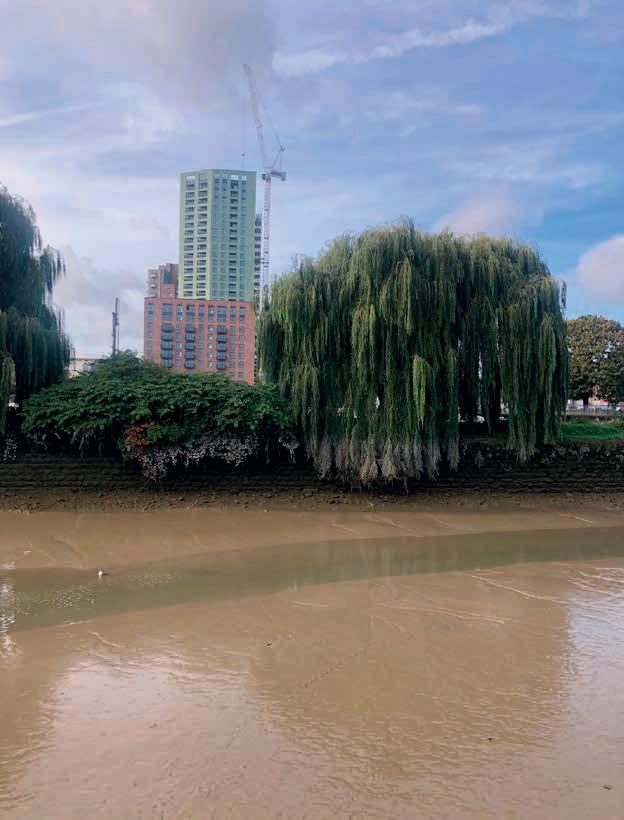
54 Research | Emerging Territories
Intertidal zone at the Lower Lea Valley
Water Insecurity and Gender-Based Violence: Exploring links and steps for prevention. A comparative study of Indonesian and Peruvian women
Stroma Cole
THE PURPOSE OF the study was to investigate the potential link between household water insecurity and gender-based violence (GBV) in Indonesia and Peru. It also aimed to identify factors that may be related to the vulnerability or resilience of women in these study areas to household water insecurity.
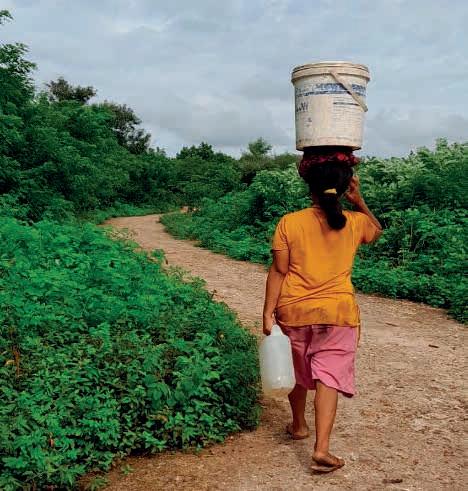
The larger goal was to use this knowledge to inform locally-appropriate strategies to reduce water insecurity and GBV in the study areas. Starting with a review of the global literature on water insecurity and GBV, it was found that no other studies have used robust qualitative or quantitative data or have been conducted outside of Africa or South Asia (Tallman et al., 2023). This study uniquely
found a qualitative and quantitative association between household water insecurity and GBV in Indonesia. These findings have been submitted for publication (Cole et al., submitted). Furthermore, we identified extended risks of household water insecurity to include indirect impacts on women’s health and well being in Peru and Indonesia (Tallman et al., submitted). This included issues such as teenage pregnancy (Archdeacon et al., 2023). Policy recommendations were developed in collaboration with non-governmental organisations to mitigate the risks of GBV and promote gender-sensitive water interventions. Together with stakeholders, impact programmes were developed, including reproductive health education for community health workers, education for teenagers on gender equality, and calendars for households to remind them about broader issues related to gender equality and the environment.

There were several strengths from the interdisciplinary and international aspects of this study. For instance, working with mixed methods from the researchers' respective disciplines (anthropology, public health and social work). This generated quantitative findings which were presented to local stakeholders allowing for the identification of solutions. Qualitative data provided insights into the dynamics at play that lead to GBV in the context of water insecurity. Combined findings were used to inform action and garner impact.
This project showed that GBV and water insecurity are connected and that GBV is not only a social and health problem but is intimately connected to environmental resource scarcity, governance and infrastructure.
Place and Experience | Research
:
Water insecurity means women in Sumba suffer from physical, psychological, structural and slow violence
Mapping the 15-Minute City
Enrica Papa (Principal Investigator)
Julian Allen (Research Fellow)
THREE YEARS AGO, Anne Hidalgo campaigned for her re-election as mayor of Paris with the promise to make the French capital a 15-minute city. Since then, numerous international cities have joined the 15-minute city goal of sustainable mobility and transport in inclusive and climateneutral cities.
However, the practical implementation of the concept is highly dependent on context and varies significantly with different neighbourhoods according to demography, the socio-economic structure of the local population, and the economic, morphologic and institutional landscape.
With its 15-minute City Transition Pathway, the European partnership Driving Urban Transitions to a Sustainable Future (DUT) aims to address this knowledge gap. One of the main goals is the creation of a 15-minute City Innovation Portfolio, which will pool knowledge on strategies, policies and other aspects of implementing the 15-minute City concept with each city's different parameters.
The 15-minute City Mapping Project provides an initial overview for the Innovation Portfolio and solid analytical methods for collecting international experiences, tools and best practices to follow phases of the Portfolio roadmap for the 15-minute City Transition Pathway.
In line with the DUT’s 15-minute City Transition Pathway’s approach, we interpret the 15-minute City concept as a mosaic of measures and activities for urban transitions in four main fields or Key Areas:

1) personal mobility;
2) urban planning and public space;
3) urban logistics; and
4) innovative governance.
Those areas are among the main categories used to map international experience in this project and derive key criteria and elements for deeper analysis of selected case studies.
Additionally, the project will show whether and how the concept can be applied in less central and less dense areas with high car dependency levels.
With the results of this project, we will lay the foundation for the development of the Innovation Portfolio and thus focus the discussion of the 15-minute City on the concrete implementation of the concept in practice.
56 Research | Emerging Territories
15 Minute City
Parking
street,
[left-right]:
spot,
neighbourhood, city
The project is run by an international consortium that includes: Technical University of Munich, University of Westminster and University of Porto
Accessibility and Connectivity Knowledge Hub for Urban Transformation in Europe (ACUTE)
 Enrica Papa (Principal Investigator)
Sabina Cioboata (Research Fellow)
Enrica Papa (Principal Investigator)
Sabina Cioboata (Research Fellow)
Funder: ESRC – JPI
WITH THE AIM of envisaging more sustainable urban development pathways that address current global challenges, a series of projects were funded under the Joint Programming Initiative of the European Commission call on Urban Accessibility and Connectivity (ERA-NET ENUAC, 2021-2024). The projects address sustainable urban passenger mobility, freight transport and connectivity as integral parts of sustainable urban development, and bring together partners across the academic, government, civil society and private sectors.
Within this framework, the Accessibility and Connectivity
Knowledge Hub for Urban Transformation in Europe (ACUTE) was launched in 2022 in order to facilitate cross-project co-operation within the ENUAC programme. The hub is composed of a consortium of multi-disciplinary researchers and practitioners from five European countries, with Dr Enrica Papa leading Work Package 1.
ACUTE is expected to support ENUAC by conducting a synthesis of results, connecting the projects and consolidating a network of complementary competences and knowledge in the field of accessibility and connectivity. Thus, it will identify results with a potential for further investigation and validation, engaging practitioners, funders and policy makers in order to facilitate the translation of research into practice. By conducting research on the funded ENUAC projects, It will map their collaboration networks, and lead a series of engagement and networking activities.
In this sense, the ACUTE knowledge hub is designed as a flexible instrument for enhancing collaborative scientific research and innovation for tackling complex, multi-sectorial challenges by enabling research, networking, coordination and capacity building across transnationally-funded research at European level.
Emerging Territories | Research Knowledge gathering exercise
Climate Cartographics
Lindsay Bremner (Principal Investigator)
John Cook
Ben Pollock
NOrTHolt RACECOURSE ESTATE MAP

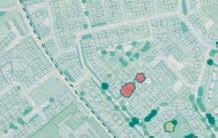
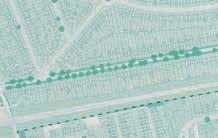
CLIMATE CARTOGRAPHICS IS a Proof of Concept

Grant to investigate the commercial potential of the mapping techniques developed during Monsoon Assemblages, a European Research Council funded project that ran 2016-2021. Our cartographic methods combine climatic, geographic and societal data to produce visually powerful maps and data visualisations of the impacts of climate change on particular sectors and contexts. To test the feasibility of this idea, this grant has enabled us to undertake market research into competitive products and services, understand who the key market players are, profile potential clients for our product, and learn what market drivers, barriers and triggers they might face are. In addition, we have investigated the IP and data security issues our innovation raises and scoped out the strengths and weaknesses of potential commercialisation strategies.


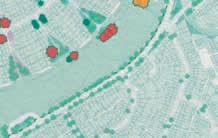
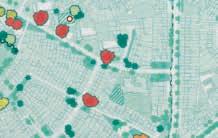

Most importantly, we have pilot projects with partners from different sectors to develop how our services can assist customers from across public, private, not-forprofit and academic sectors. We have partnered with: the Active Travel Academy, the NGO Trees for Cities, Southwark Council, and Pelagian, a private under-sea cable company. These projects have enabled us to refine our value proposition for each sector and undertake market segmentation within and across sectors. It has highlighted how each client has different cartographic needs, and how to tailor the services we provide to meet their requirements, including: type of product, depth of enquiry
and presentation, methods of delivery and engagement, and differences in price and ways of calculating it.
RACECOURSE ESTATE MAP


Piloting has tested and expanded our cartographic repertoires in response to client briefs and provided data on which to compare their needs and develop a grid of criteria to guide future work and build future markets. By the end of the Proof of Concept phase we aim to have formalised contracts with at least one client from each sector for future work.


58 Research | Emerging Territories
Trees Estate. as There as are There raised Northolt by A aiming Shoots involved information. LEGEND
Climate Pamphlet
Trees for Cities, Prince Consort Lodge, Kennington Park, London, SE11 4AS
Trees for Cities planted 61 different types of tree at Racecourse Estate. The map shows 12 key species you’ll see around the estate, as well as the positions of other trees we have planted since 2019. There are lots of fruit trees apple, mulberry, plum, cherry and pear as well as the ancient and lesser known quince and medlar which are inedible raw but used to make jams and jellies. There is also new seating including five oak picnic benches with raised beds and six additional benches along the main path in Northolt Park. Northolt Park also has a new tree trim trail inspired by local school pupils and spiral orchard. A new greening group called Green Shoots has been established, aiming to enhance and protect greenspaces on the estate. Green Shoots has a WhatsApp group for anyone who would like to be involved please email greenshoots.northolt@gmail.com for more information. LEGEND Wild Service Tree Black Poplar Small Leafed Lime Black Walnut Tibetan Cherry Golden Alder NOrTHolt
250m Sweet Gum Apple Turkish Hazel Swamp Cypress Medlar Persian Ironwood Existing Tree Trees for Cities Planted 2019 2023 Climate Cartographics Pamphlet + Graphics Hedgerow Bench Bulb Planting Raised Beds
Map of tree planting by Trees for Cities at Northholt Racecourse Estate. [Map by Ben Pollock and John Cook]
THIS IS AN international, interdisciplinary, intercultural project to reimagine the ‘good city’ from Ennore Creek in north Chennai, India. The creek is a tidal channel with extensive wetlands that were once dense with diverse habitats and interwoven histories – mangroves, saltpans, marshes, sand dunes, fish, crabs, prawns, and humans of various castes, occupations and cultures. From the 1960s, many of these lives, linkages and histories began to unravel with the descent into this watery landscape of a state-sponsored heavy industry complex which obliterated and transformed it into a contaminated techno-scape. Local fishers and artisanal communities, whose lives were almost erased by these changes, fought
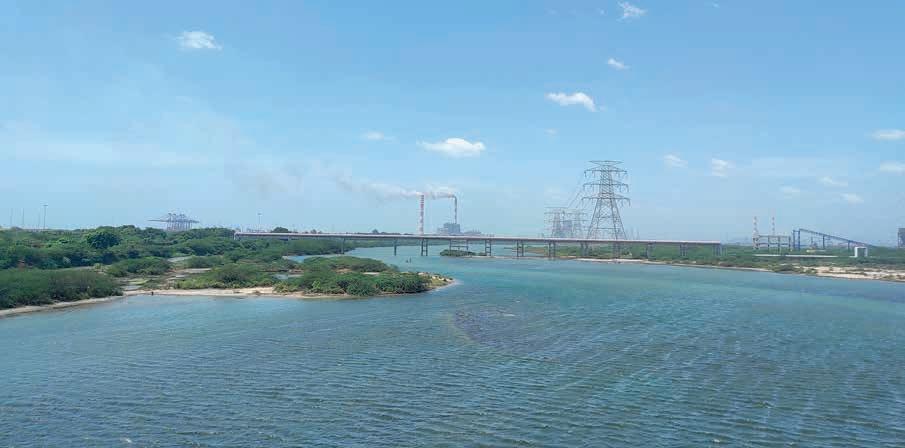
Reimagining the Good City from Ennore Creek
Lindsay Bremner (Principal Investigator)
Karen Coelho
Nityanand Jayaraman
Asif Qureshi
Bhavani Raman
Aditya Ramesh
back. Their struggles to reclaim the wetlands and their livelihoods have been multi-stranded and multi-layered, with shifting frames, methods, actors, audiences and collaborators.
Drawing on interviews and stories gathered from local people, on archival research, including the archives of the Save Ennore Creek Campaign, and on a variety of co-design strategies, the project is bringing together diverse communities of knowledge and practice to tell the history of the creek and to co-design its ecorestoration as a thriving lifeworld and buffer against weather extremes and climate challenges.
Emerging Territories | Research
Staff : John Cook, Gajendran V., Raju K.
Ennore Creek, north Chennai, India.
[Photo: Raju K.]
Experiments in 'Torsegrity': Helical frameworks with torsional integrity
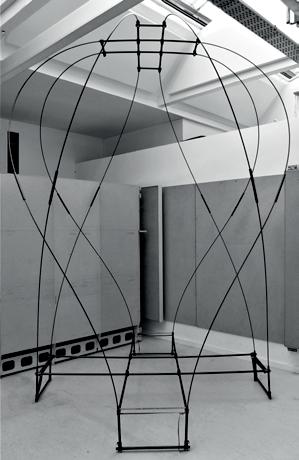
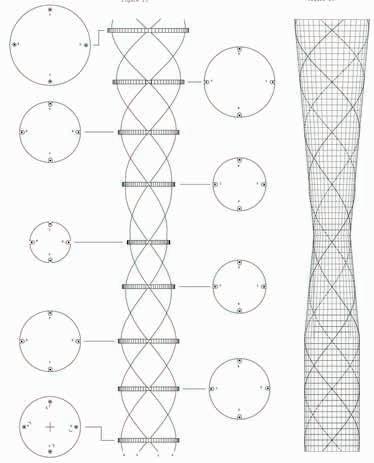
Pete Silver
Fabrication and Assembly: Will McLean, FABRICATION LAB staff (David Scott, François Gerardin, Christian Newton, Guy Sinclair and Kristina Veleva). Thanks also to Harry Charrington for his support.
THERE IS A CONTINUING need to develop lightweight but strong structures that are quick and easy to assemble, thereby minimising their embodied energy and use of natural resources. For example, diagrid structures, like Lamella domes, use less material than conventional frames when deployed for buildings and roofs. Similarly, structures like cable-stayed, suspension or ‘tensegrity’ structures demonstrate a high strength-to-weight ratio by assembling discrete structural elements so that compressive struts are held in place spatially by tensile wire or rope.

In 2022, Pete Silver was granted a UK patent for his novel structural system: Helical Structural Framework with Torsional Integrity Both natural and synthetic materials of various dimensions and cross-sections that can undergo elastic deformation may be employed. Examples include
Carbon fibre products: Easy Composites Ltd.; Connecting components: RK Rose+Kreiger.

For a full description of UK patent number GB2594037B see: ipo.gov.uk/p-find-publication.htm
bamboo, young (green) timber shoots, and carbon-fibre and epoxy composites. It seeks to provide a threedimensional structure based primarily on the principle of stiffening linear elements with a low elastic modulus to form arcs. These elements may be applied as structural components within a building such as columns, beams, or trusses, or form entire structures such as bridges.
The School of Architecture + Cities sponsored Silver to build a set of large-scale prototype structures to complement his own proof-of-concept models. Carbon fibre rods are used to form splines which are held in torsion by rigid elements made from 18mm-diameter carbon fibre tubes with reinforced polyamide connecting components. The forces exerted by opposing splines cancel each other out to generate structural integrity.
60
Research | Making + Practice
(left) Drawings; (centre top) Test model; (centre bottom & right) Proof-of-concept models – 8mm dia. carbon fibre rods held in torsion by a rigid scaffolding of 18mm dia. carbon fibre tubes with reinforced polyamide connecting components
Interpreting Ephemeral Heritage of Displaced Communities: Case study of Syrian refugees in Jordan
Maja Jović
THE ENVIRONMENT OF a refugee camp is novel; it does not repeat nor duplicate any environment people who reside there have lived or dwelled in before. If a certain living environment is composed as an assemblage of relations, materialities and politics, then the refugee camp's environment is one of a kind and so is its heritage.
The Interpreting Ephemeral Heritage research cluster sits at the intersection of several disciplines including: refugee camp studies, heritage studies, post-conflict studies, tourism and architecture. It is led by Dr Maja Jović (University of Westminster) and Dr Aya Musmar
(University of Petra). The cluster was initially formed in 2021 under the umbrella of the Regenerating Cities During Crises project, a collaboration organised between University of Portsmouth and University of Jordan and funded by the British Council and Newton Fund.
Cultural heritage is often associated with iconic archaeological sites or widely shared practices, but the last few decades has seen a shift in this thinking to question broadly why it is important, why it is at risk and what can be done to protect it. In the refugee camp environment, there is an added layer of ephemerality and transitioning that the research group is particularly interested in.
At the same time, despite debates on its ethics, there is a continuing rise of interest in dark and slum tourism, and refugee camps are spaces where this type of tourism has been seen to have started to develop. The research cluster was thus formed to interrogate the extent, value and validity of recording and interpreting the ephemeral heritage of these displaced communities.
Jović received QR Funding to travel to Jordan to continue the work to develop this research and visit sites of interest, most notably Za’atari Refugee Camp (in collaboration with International Rescue Committee). She delivered a lecture at the University of Petra on the neoliberal approach to regenerating post-conflict cities, reflecting on decision-making processes and their cultural identity. The workshops she co-organised in Jordan focused specifically on interrogating outsiders' motivations to visit a refugee camp in an attempt to understand the relationship between the voyeur's gaze and the ephemeral heritage of the displaced communities, as well as comment on the ethical implications of these activities.
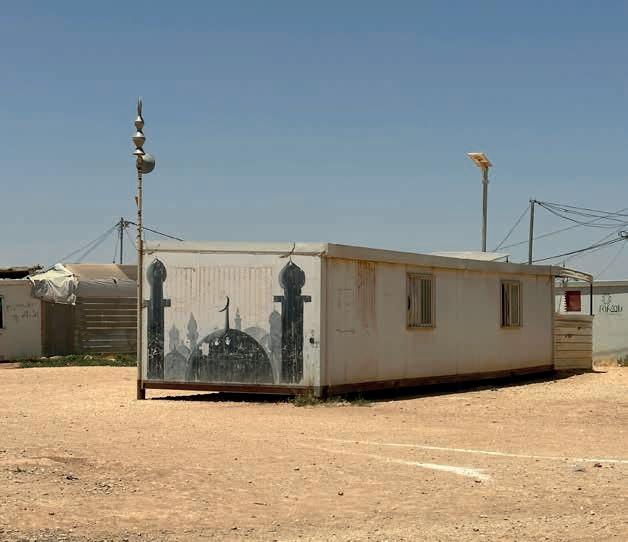
Place and Experience | Research
Life in Za’atari camp: Prefabricated container turned into a place of worship
Moving Pictures: Reusing cinemas as places of worship in the diaspora

Kate Jordan (Architecture + Cities)
Julie Marsh (Westminster School of Arts)
USING PIONEERING CROSS-DISCIPLINARY methods, this project examines the adaptive reuse of cinemas as places of worship. In so doing, it captures a vital snapshot of faith and diaspora in contemporary urban landscapes which could inform future heritage practices. A broad survey of converted cinemas used as places of worship will support close readings of specific sites in London.
In addition to offering a picture of faith in the twenty-first century, the case studies will provide valuable information on the role of planning in the reuse of heritage buildings, exploring practical constraints but also the potential for generative dialogue. The project will combine scholarly research with the innovative art-based methodology, ‘Site-integrity’ (developed by the project’s co-leader,
Funded by Royal Institute of British Architects (RIBA) https://moving-pictures.info/
Julie Marsh) to gather data and record material through film, audio recording and oral histories. These outputs reflect the architectural significance of the case studies' former existence as cinemas. To understand the wider context, the team will visit a selection of cinemas that have been reused as mosques, temples and black majority churches across the UK. In each of the site visits and case studies, the research will explore encounters between heritage bodies, local communities and faith groups, examining intersections of the sacred and secular; assimilation and autonomy. By uncovering the role of faith communities in shaping and negotiating their own spaces, the project will demonstrate that adaptive reuse of heritage buildings by diaspora communities is a practice that is culturally enriching, environmentally sustainable and socially inclusive.
62
Research | Architectural Humanities
Former Granada Cinema (now Christ Faith Tabernacle Cathedral), Woolwich (1936-37).
Theodore Komisarjevsky (Interior) with Cecil Masey & Reginald Uren (Exterior) [photo © Sirj Photography]
RE-IMAGINING CORAL REEFS is a cross-disciplinary collaboration between architecture researchers, design students and marine biologists to explore VR and the metaverse as critical design tools to communicate vital climate science to a wider audience.

As vital ecosystems that sustain 30% of all ocean species, efforts to understand and preserve coral reefs constitute a critical endeavour that brings together scientists, designers, local communities, NGOs and governments. However, these viscerally rich environments and the multi-sensory data gathered from them are typically represented through conventional media. Consequently, the emotive and uplifting efforts to protect coral habitats are lost to the public, under the dominant climate narrative of
Re-Imagining Coral Reefs
John Zhang
Ben Williams (UCL/ZSL) Jason Lynch (UCL/ZSL)
doom and gloom. Meanwhile, discourse in virtual reality (VR) and the metaverse – the very tools and environments that are capable of creating multi-sensory experiences –are dominated by conversations around gaming and social networking.
Using digital tools typically deployed in architectural practice and spatial design, this project bridges this gap. Field data collected from coral reefs in Indonesia is transformed into an immersive and interactive VR environment, through which the public can experience healthy, degraded and re-imagined coral reefs. Co-created by architecture researchers, marine biologists and students, these digital and virtual investigations are accompanied by explorations in 3D-printed prototypes, with the project development process captured on film.
In exploring VR and the metaverse as a new medium to represent climate data, the project aims to bring different strands of coral research together in a single accessible scientific call for action. As a creative practice, the project investigates the capacity of the metaverse as a space to explore non-human perspectives in the representation of climate science, from where designers and scientists can collaborate and co-create, giving form to the emotive impetuses that underscore scientific endeavours.
Making + Practice | Research
Project concept
Funded by Quentin Hogg Trust
Low Traffic Neighbourhoods in London: A mixed-methods study of benefits, harms and experiences
Ersilia Verlinghieri
Rachel Aldred
Patrice Ajai-Ajagbe
Jamie Furlong
Harrie Larrington-Spencer
Low traffic neighbourhoods (LTNs) are transport interventions that limit through-traffic motor vehicle access in a set of residential streets. Their aim is to make walking, wheeling and cycling safer and more comfortable, and make driving less convenient.
There is some promising evidence of the benefits of LTNs, including decreased car ownership and use, increased active travel, and a reduction in street crime and road traffic injuries. However, there is also concern about adverse impacts, for instance on disabled people who need to use cars and whose journeys will be longer, or for residents on boundary roads which may experience the negative consequences of diverted motor traffic.
Funded by the National Institute of Health and Care Research, the ‘Low Traffic Neighbourhoods in London’ project uses both quantitative and qualitative methods to examine the benefits, harms and experiences of new
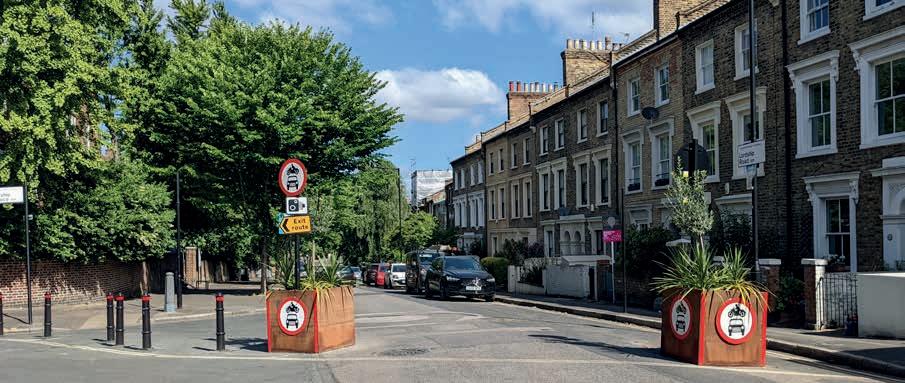
Funded by National Institute for Health and Care Research (NIHR)
LTN schemes and inform the future of similar transport interventions.
One key component of this work is ‘go-along’ interviews with residents who live in or nearby an LTN. During the go-along, residents are asked to guide researchers around their local area; they discuss their daily experiences of living within or near the low traffic neighbourhoods and how the scheme impacts them and their journeys, both positively and negatively. The method allows researchers to better understand the inclusivity of the schemes, such as the experiences of disabled people and older residents who have diverse travel needs and might use roads differently. At the same time, go along interviews enable researchers to highlight potential positive or negative impacts not easily captured by quantitative data or traditional interviews, including changes in perceptions of safety of the local environment or changes to the way public space is used.
64
Modal filter for a Low Traffic Neighbourhood (LTN) in Stoke Newington, Hackney
ACADEMY TRAVEL ACTIVE Research | Active Travel Academy
Re-imagining London’s Streets: What drives attitudes to active travel funding?
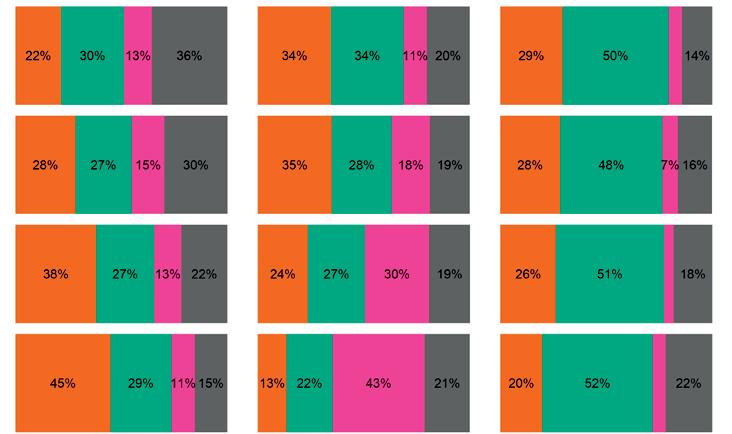
Jamie Furlong
David Fevyer



Rachel Aldred
THE SHIFT EXPERIENCED during the COVID-19 pandemic to more people walking and cycling, exposed the unequal allocation of space in Britain’s towns and cities for different transportation methods. In response, the government created an Active Travel Fund to support English local authorities to rapidly improve cycling and walking facilities. This funded a range of schemes (e.g. protected cycle lanes, pedestrian crossings, School Streets and Low Traffic Neighbourhoods). Some have been controversial and not all remain. For instance, in London around 130 Low Traffic Neighbourhoods were implemented in 2020-2021, but around thirty have since been removed. What determines people’s attitudes to these kinds of investments in walking and cycling? Who wants more funding for active travel, and who thinks there is already too much?
Using the Travel and Places TfL Survey data, which has around 1,500 repeat respondents in three waves, the team have been investigating associations between travel behaviour and attitudes, and demographic variables. Analysis has already found interesting demographic associations; for instance, around car ownership or age and attitudes to investment in different transport modes. Other topics to be explored with a third year of data include impacts of local ‘bikeability’ (quality of the local environment for cycling) on travel behaviour and attitudes, and whether getting to know a cyclist affects attitudes to cycling and cyclists.

Survey findings to the question: Are TfL and your local authority doing enough to support transport in your area? ACADEMY TRAVEL ACTIVE 18-24 25-49 50-64 65+ Age group
Active Travel Academy | Research Too little About the right amount Too much Don't know
Funded by Transport for London (TfL)
Car-free Megacities
Rachel Aldred
Athena Brook
Charlie Couve
Jamie Furlong
Asa Thomas
Ersilia Verlinghieri
THIS ONGOING COLLABORATIVE project with climate action charity Possible (funded by KR Foundation) aims to reimagine our cities as places where private cars are obsolete, starting with London, Paris and New York, and has led to the ATA producing a range of reports on topics related to active travel and reducing car use. For instance, Ersilia Verlinghieri led a high-profile study on cargo bikes and their potential to replace vans in inner London. She has also led a report looking at Paris’ recent transformation with the introduction of bike lanes, greening and School Streets. Interviewing a range of stakeholders and advocates, her work has sought to understand how the changes were implemented and what the barriers and enablers were. Another report led by Ersilia Verlinghieri as part of this project has involved speaking with businesses in north London about the experiences of local streetscape changes.
Jamie Furlong recently led research looking at the impact of councillors’ tweeting about Low Traffic Neighbourhoods on voting patterns in London. This found that there was no clear correlation between LTN Tweets and reelection outcomes; if anything, tweeting about LTNs may have had a slightly positive impact on votes, although the relationship was different for Labour and Conservative councillors. The report was interesting because often controversial schemes are assumed to have large effects on voter sentiment and behaviour, but the research suggested that this may not actually be the case.
Funded by Possible

66 Research | Active Travel Academy
Report created as part of Car-free Megacities collaborative project
ACADEMY TRAVEL ACTIVE
THE AIM OF the project, carried out in partnership with the EFBWW, is to analyse and understand changes in the construction industry, particularly in the scaffolding sector, to identify areas of possible action and develop policy concepts and proposals for those areas in which the EU is responsible.
In this context, the research activities consist of:
1) Supporting and coordinating the project partners in the elaboration of six country reports, namely for Belgium, Denmark, Germany, Ireland, Poland and the Netherlands; detailing the economic situation of the scaffolding sector; the working conditions in the sector with some focus on occupational hazards; the training systems in the participating countries and in Europe,
School of Architecture + Cities: Rosa Schiano-Phan
Filomena Russo
WBS: Maria Christina Georgiadou
Fernando Duran-Palma Linda Clarke
specifically the Occupational Safety and Health (OSH) training; the changes in the technical composition of scaffolds and used tools and the related standardisation work, but also regarding their environmental sustainability, digitisation and robotisation in scaffolding activities and later the use of scaffolding.

2) Evaluating the country reports and producing an overall research report based on the findings which will further address the feasibility of a European OSH Certificate for the scaffolding sector, as well as other policy recommendations on working conditions, training and technological change.
3) Running workshops and engaging in dissemination activities.
ProBE | Research SCAFFOLD
Improving Training, Working Conditions and Transformation in the European Scaffolding Sector
Funded by European Federation of Building and Woodworkers (EFBWW) and the European Union (€30. 000)
100k Fuel Poor Homes Retrofit Review
School of Architecture + Cities: Rosa Schiano-Phan Filomena Russo
School of Applied Management, WBS: Maria Christina Georgiadou
THIS INTERDISCIPLINARY RESEARCH project investigated the progress made by the London Mayoral Office in retrofitting fuel poor homes in London, as part of the pledge to the Just Transition campaign led by the NGO, Citizens UK.
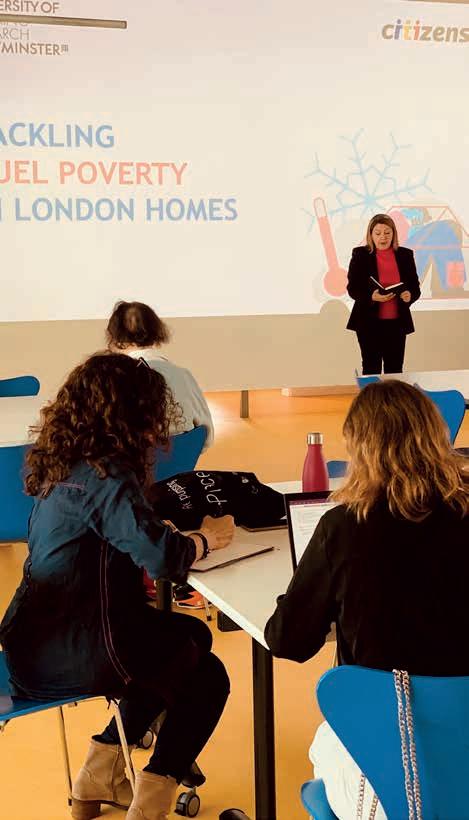
The research, undertaken between May and July 2023, involved a desktop-based state-of-the-art review on fuel poor homes retrofit in London. An overview of existing theoretical frameworks around fuel poverty definitions, energy efficiency and retrofitting in residential buildings was conducted. The study included an analysis of relevant existing databases and published reports. Freedom of Information requests were sent to the 33 London Boroughs and the GLA to collect data on the number of retrofitted homes since 2021. The results of the desktop analysis and FoI data collection were tested at a workshop in July where focus groups of relevant stakeholders, including academics, politicians and GLA officers and Local Authorities, fed back on the findings of the review.
The research concluded that although an initial understanding of the Mayor’s commitment appeared to indicate an intention to upgrade a total of 100,000 fuel poor homes before the end of the current mandate, there was never a formal commitment to a binding number of residential units but instead a promise to continue working to achieve larger numbers together with the G15 housing association group. A final report is currently under peer review, and it documents the number of retrofits reported by LA and G15 to date.
MSc AED Vertically Integrated Project: Agostino Anselmo
Rayman Laurel Mathieu Arnoud Naccarato
Funded by Research England, Participatory and Policy Research Fund (£8,000)
68
Fuel Poverty & Home Retrofit Focus group
Research | ProBE
Women in Construction and Wood and Forestry Sectors
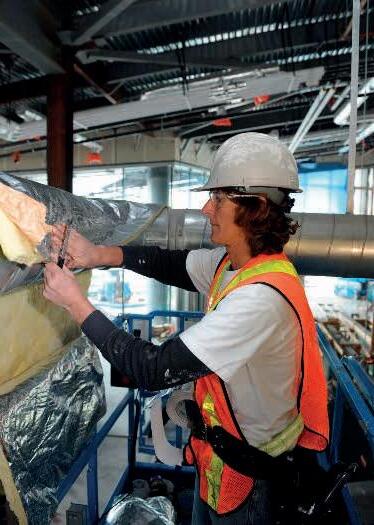
School of Architecture + Cities: Rosa Schiano-Phan
Coralie Guedes
School of Applied Management, WBS: Maria Christina Georgiadou
Fernando Duran-Palma
Linda Clarke
THE OVERARCHING AIM of this project, carried out on behalf of the European Federation of Building and Woodworkers, is to strengthen, reinforce and promote gender equality and women representation in the
construction, wood and forestry sectors enhancing genderbased diversity and female leadership with a particular focus on the European Sector Social Dialogue in a context of severe labour shortages.
The project entails:
1) Collecting statistical data on the presence of women in construction, wood and forestry following a new EFBWW survey questionnaire, administered in 2020-21.
2) Identifying good practices and experiences related to gender matters in collective bargaining and collective bargaining agreements (CBAs) in the construction, wood and forestry sectors. This involves a large-scale literature review on the transforming nature of the construction industry and data analysis of the above EFBWW survey questionnaire.
3) Producing a practical and sector-specific manual for practitioners that includes tools and resources for increasing the participation of women in the construction, wood and forestry sectors.
4) Identifying priorities for EFBWW gender policies on EU level, with a particular focus on the European Sectoral Social Dialogue.
5) Presenting the manual and engaging in a wider discussion with external stakeholders (employer representatives) at a side-event during the General Assembly of the EFBWW.
ProBE | Research
Women in Construction and Wood and Forestry Sectors [photo: BC Insulators Union]
Funded by Friedrich-Ebert-Stiftung (€15, 000)
PHD STUDENTS IN the School of Architecture + Cities are engaged in wide-ranging areas of research that fall within and across the School’s five research groups: Architectural Humanities; Emerging Territories; Making and Practice; Place and Experience; and Transport and Mobilities. Recently completed theses have made pioneering contributions to global scholarship in tourism, climate change, transport and architectural theory. Those who completed this year include Frances Kremarik, whose thesis entitled ‘The Changing Nature of Long-Haul Traffic on the North Atlantic: An examination of airline network strategies’; and Lida-Evangelia Driva who was awarded an MPhil for her thesis entitled, ‘The Operation of the Hidden: Towards an understanding of architectural urban space; the case of Omnia Square’.
In addition to standard-route PhDs, we continue to supervise students working towards PhD by Published Work and PhD by Practice. The practice and published
work models offer routes into postgraduate study for outstanding professionals with an established body of work and have helped to forge valuable connections with industry. Recently completed PhDs by Published Work include ‘Doors that could take you Elsewhere: The architectural practice of reading science fiction’ by Amy Butt and ‘The Values of Urban Design – Spatial Models’ by Alain Chiaradia. Nicola Murphy completed a PhD by Practice entitled, ‘Slow Practice: (Re)drawing time balancing narratives, ghosts and tensions’.
This year Dr Constance Lau was successful in securing a prestigious Techne Collaborative Doctoral Award, in partnership with the Zaha Hadid Foundation. Constance will be supervising Architecture + Cities alumna, Laura Nica, who won the studentship.
For further details about our PhD programme, visit: https://www.westminster.ac.uk/study/postgraduate/researchdegrees/thinking-of-doing-a-phd
Kate Jordan PhD Coordinator
70
PHD
PhD candidates, 2023
Hala Alnaji
Katherine Bartlett
Athena Brook
Alain Chiaradia
Didem Ertem
Minerva Fadel
Jennifer Fernando
Karen Fitzsimon
Shengkang Fu
Asa Henry Patrick Thomas
Sugandhi Jayaraman
Prajakta Kalamkar
Iman Keaik
David Littlefield
David Mathewson
Joao Matos Da Silva
Nicola Murphy
Anishka Narula
Simona Palmieri
Dulce Pedroso
Luis Pinto
Marzena Piotrowska
Dawn Rahman
Fred Raphael
Rofayda Salem
Rick Schumaker
Rachel Simmonds
Xinyao Song
Lorna Stevenson
Sally Stone
Cristina-Alexandra Trifan
Carine Woiezechoski
Mengran Zhu
72
Forming bonds and shared experiences while cycling with children

Mad or Magnificent? Mothers who cycle with their children
THIS RESEARCH SET out to understand the practice of mothers cycling with their children (aged 11 and under) in the UK. As part of the research, I carried out several focus groups with women who work in cycling, surveyed approximately 1,300 mothers and conducted 30 in-depth
interviews. The mothers taking part in this research were highly motivated to incorporate cycling into their lives but had to be meticulously organised to juggle cycling with other care duties and employment.
The most popular journeys undertaken by bicycle were to education sites such as schools and nurseries, followed by those for shopping and errands, as well as visiting friends and families. Unfortunately, many of the mothers noted certain barriers when cycling, such as bad driving and aggression from other road users. Just under a quarter of mothers surveyed had experienced close passes from drivers, and more than a third had suffered verbal abuse when cycling with their children. Similarly, other issues such as guard rails, A-frames and steps on traffic-free paths often made simple journeys more complicated, particularly for those using non-standard cycles which struggle to fit through such barriers.
However, despite some of these problems, there was an overwhelming sense that cycling with children was deemed a positive and worthwhile activity to undertake. Many of the mothers taking part in the research listed the countless benefits they had found from riding with their children. These included: improved health, both mental and physical; the confidence their children gained from learning the skills to ride a bicycle; plus the sheer joy and fun of cycling together. Moreover, many of the mothers firmly believed cycling with their children allowed them to form emotional bonds and hopefully build lifetime memories.
Dawn Rahman
Supervisors: Rachel Aldred, Tom Cohen and Ersilia Verlinghieri
PhD | Research
Asa Thomas
Mediating Mobility at the School Gate: Interpreting London’s school street schemes

FOLLOWING THE INITIAL stages of the COVID-19 pandemic, the closure of streets in front of London’s schools has expanded from a marginal policy to one that covers nearly a third of state-funded primary schools across the city. This rapid or ‘tactical’ expansion has improved the air quality and public space of many of the streets by schools. However, as with other cities that have pursued similar programmes of road space reallocation in recent years, the expansion of these schemes raises several questions around the evolving nature of urban change, the fairness of these practices (and their outcomes), as well as their ability to impact urban mobility systems more systematically.
This PhD explores these questions using a mixture of methods and data, including practitioner interviews, spatial analysis of the distribution of ‘School Streets’, and school mobility data. It finds that although policymakers have been successful in rapidly introducing a widespread programme of schemes with much less controversy than similar measures, issues of equity remain; there is little evidence of prioritisation of schools facing the worst air pollution at the city-scale, and there are significant disparities across London’s administrative geography. Focusing on the impacts of these schemes on mobility, this research also shows that School Streets have had a broader impact on journeys to school, with decreased use of motor vehicles detected. These findings contribute to wider debates surrounding the role such ‘tactical’ approaches to streets have on influencing how people travel in the city.
74
Research | PhD
Road closure scheme in place outside London school
Supervisors: Rachel Aldred, Tom Cohen, Jamie Furlong
Prajakta Kalamkar
Supervisors: Krystallia Kamvasinou and Andrew Smith
Digital Placemaking: Co-creating temporary public places using digital technologies
THE COVID-19 PANDEMIC highlighted the prominence of two key trends in urban social life: the rapid digitisation of society and the increased need for urban public spaces. These have significantly changed socio-spatial relationships and patterns of behaviours, meanings and representation in the urban built environment. While digital technologies are embraced as a convenient and feasible means of socialisation, on the other hand the effects of heightened digitisation on everyday life (such as zoom fatigue and isolation) resulted in an increased need for urban public spaces.
This research focuses on digital placemaking, a concept which engages people in places through digital technologies, and asks: ‘How can digital placemaking facilitate communities to co-create meaningful urban places? By using social networks and digital technologies, digital placemaking provides communities with new opportunities to form a sense of place, representation and agency
of co-creation to make or reshape a hybrid place. This qualitative research study uses urban studies methodologies to understand how people use digital technologies to co-create urban spaces and to create meaningful attachments to them.

This research is based on two case studies: Luchtsingel Rotterdam, a bridge co-created through online crowdfunding and social media; and a co-created pocket park in Barking, east London. The examination uses an innovative combination of physical and digital methods of data collection, such as Netnography and Internet-mediated desk research, combined with face-to-face interviews and on-site observations. The results of these studies will aid in a comprehensive understanding of how digital placemaking acts of co-creating public spaces can create attachment to place, and how digital placemaking can aid in the creation of place capital.
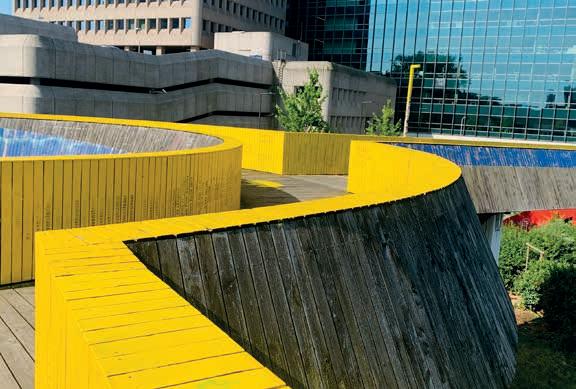
PhD | Research Online crowdfunded bridge, Luchtsingel, Rotterdam
Staff
Vasilija Abramovic
Wilfred Achille
Panagiota Adilenidou
Sam Aitkenhead
Dimah Ajeeb
Rachel Aldred
Roudaina Alkhani
Julian Allen
Ian Arnott
Alessandro Ayuso
James Baldwin
Russel Bamber
Simon Banfield
Mark Bannister
Pete Barber
Tessa Barraclough
Scott Batty
Susanne Bauer
Nick Beech
Ross Bennett-Cook
Carine Berger Woiezechoski
Sabina Blasiotti
Alastair Blyth
Stefania Boccaletti
Mehrdad Borna
Roberto Bottazzi
Andrew Boughton
Anthony Boulanger
Lindsay Bremner
Florian Brillet
Stephen Brookhouse
Christopher Bryant
Tom Budd
Toby Burgess
Aleksandra Cannock
Mengqiu Cao
Paolo Cascone
Ian Casey
Harry Charrington
Conor Clarke
Tom Cohen
Stroma Cole
Jim Coleman
Mark Coles
Andrew Cook
John Cook
Jonathan Coventry
Beth Cullen
Wajiha Dadabhoy
Miriam Dall’Igna
Christopher Daniel
Corinna Dean
Dusan Decermic
Luis Delgado Munoz
Nigel Dennis
Davide Deriu
Zoe Diakaki
Richard Difford
Orsalia Dimitriou
Kirti Durelle
Liz Ellston
James Engel
Bill Erickson
Elantha Evans
Helen Farrell
Amr Fawzy
Tomas Fiszer
Alex Fox
François Girardin
Simone Gobber
Inan Gokcek
Nasser Golzari
Joana Soares Goncalves
Anne Graham
Sean Griffiths
Thomas Grove
Eric Guibert
Yannick Guillen Sloma
Gérald Gurtner
Alison Gwynne
Johannes Hagan
Clare Hamman
Jeremy Hammant
Lindsey Hanford
Stephen Harty
Ed Harty
Adam Holloway
Thomas Hopkins
Md Mohataz Hossain
Sam Sam Hui
Zac Ibrihimi
Clare Inkson
Bruce Irwin
Sho Ito
Caroline Jackson
Josef Jammerbund
Kate Jordan
Maja Jovic
Angela Kailisch
Ripin Kalra
Rim Kalsoum
Krystalia Kamvasinou
Paol Kemp
Neil Kiernan
Jennifer Kingston
Michael Kloihofer
Mary Konstantopoulou
Maria Kramer
Frances Kremarik
Debbie Kuypers
Diony Kypraiou
Ed Lancaster
Constance Lau
Chantal Laws
Dirk Lellau
Jacques Leonardi
76 School of Architecture & Cities | Staff
Sebastien Leow
Christopher Leung
David Littlefield
Tony Lloyd-Jones
Gwyn Lloyd-Jones
Ian Lowden
Maria Lozano Lara
Jayne Luscombe
Jane Madsen
Evangelia Magnisali
Arthur Mamou-Mani
Balveer Mankia
Anna Mansfield
Andrei Martin
Max Martin
David Mathewson
David McEwen
William McLean
Alison McLellan
Joanna Meehan
Marina Mersiadou
Tabatha Mills
Fatemeh Mohamadi
Irene Roca Moracia
Bongani Muchemwa
Richa Mukhia
Rutendo Musikavanhu
Cheryl Mvula
Robert Nathan
Luz Navarro
Suzy Nelson
Michael Neuman
Natalie Newey
Andreea-Laura Nica
Antonia Noussia
Johannes Novy
John O’Shea
Jamie Ogilvie
Chiara Orefice
Samir Pandya
Enrica Papa
Ilaria Pappalepore
Roman Pardon
Jake Parkin
Paresh Parmar
Deborah Pearce
Mirna Pedalo
Diana Periton
Catherine Phillips
Maja Piecyk
Stuart Piercy
Marzena Piotrowska
David Pitfield
Alicia Pivaro
Ben Pollock
Sylwia Poltorak
David Porter
Kartikeya Rajput
Kester Rattenbury
Federico Redlin
Paul Richens
Katy Roberts
Toby Robins
Michael Rose
Filomena Russo
Shahed Saleem
Rofayda Salem
Vera Sarioglu
Era Savvides
Rosa Schiano-Phan
Amedeo Scofone
David Scott
David Seex
Yara Sharif
Geoffrey Shearcroft
Conor Sheehan
Abubokkar Siddiki
Pete Silver
Ian Simpson
Andrew Smith
Paul Smith
Tsz Wai So
John Somers
Ro Spankie
Afolabi Spence
Robert Spooner
Kenneth Stevens
Nancy Stevenson
Matthew Stewart
Carly Straughan
Ben Stringer
Henning Stummel
Allan Sylvester
Jane Tankard
Graham Tanner
Mireille Tchapi
Adam Thwaites
Alessandro Toti
Cristina-Alexandra Trifan
Anastasia Tsamitrou
Juan Vallejo
Athanasios Varnavas
Giulio Verdini
Filip Visnjic
Christine Wall
Richard Watson
Victoria Watson
Zhenzhou Weng
Andrew Whiting
Camilla Wilkinson
Julian Williams
Allan Woodburn
Andrew Yau
Mika Zacharias
Paolo Zaide
John Zhang
We wish to thank the following organisations for their support:





Bibliotheque McLean
NATURAL COOLING LTD


THE JAMES PHILLIPS FOUNDATION


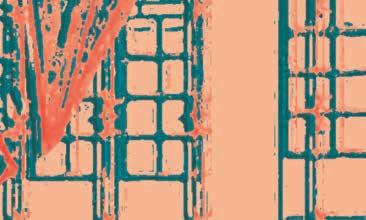




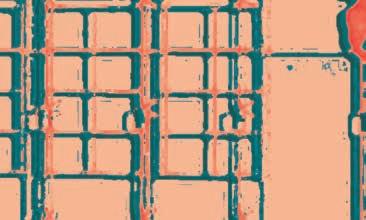
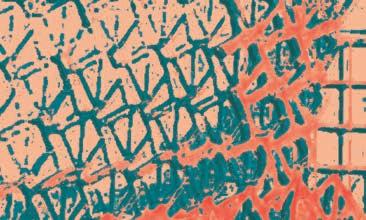





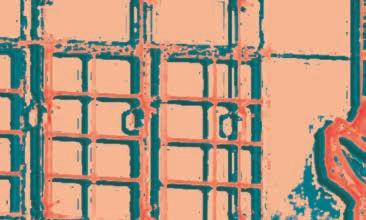

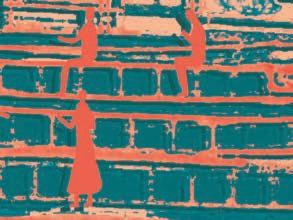






















SCHOOL OF ARCHITECTURE + CITIES University of Westminster 35 Marylebone Road London NW1 5LS Tel 020 7911 5000 x3165 www.westminster.ac.uk A C+ 2023 MORE






















































































































































































































































































































 Enrica Papa (Principal Investigator)
Sabina Cioboata (Research Fellow)
Enrica Papa (Principal Investigator)
Sabina Cioboata (Research Fellow)



































































